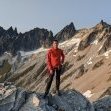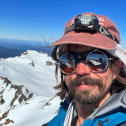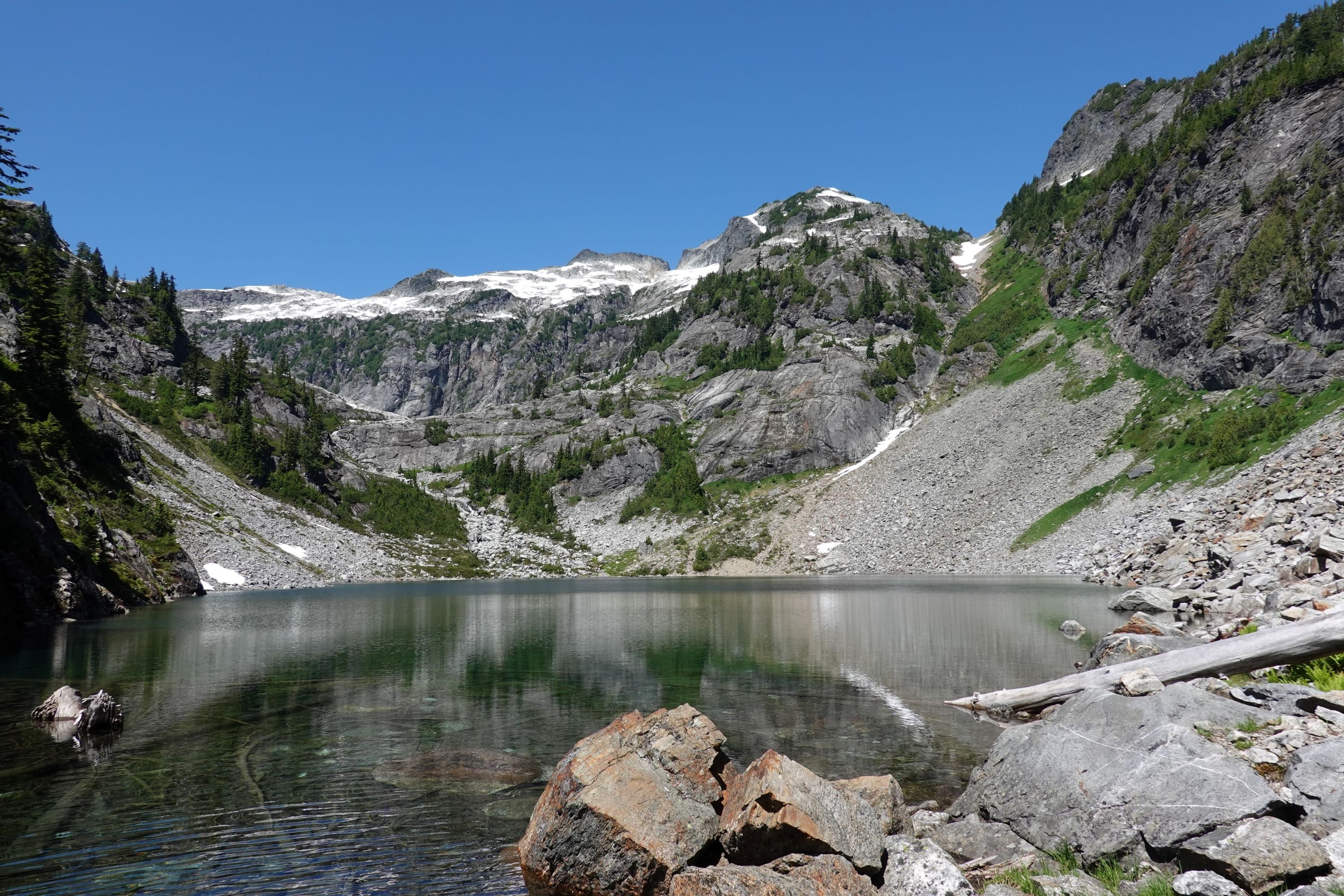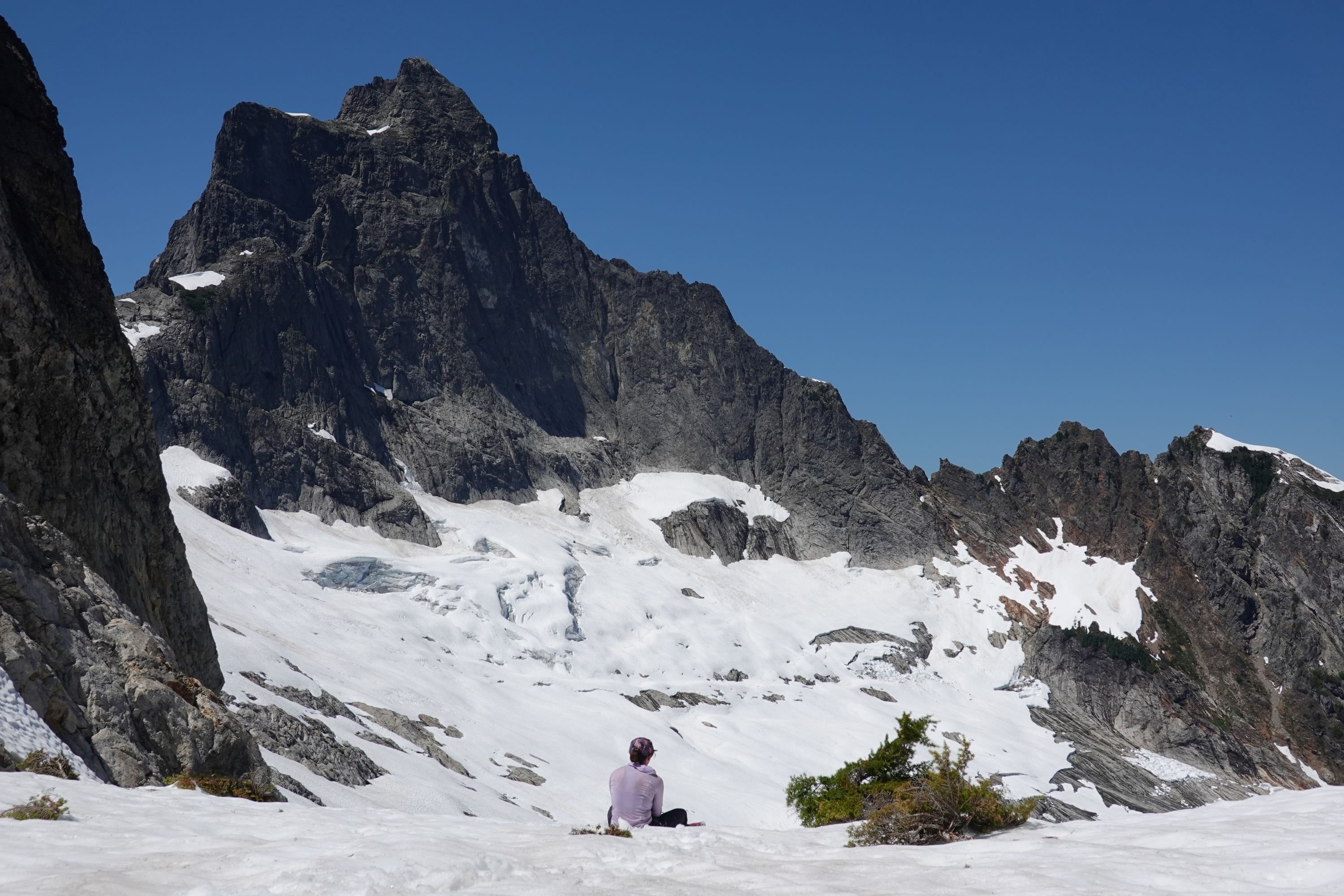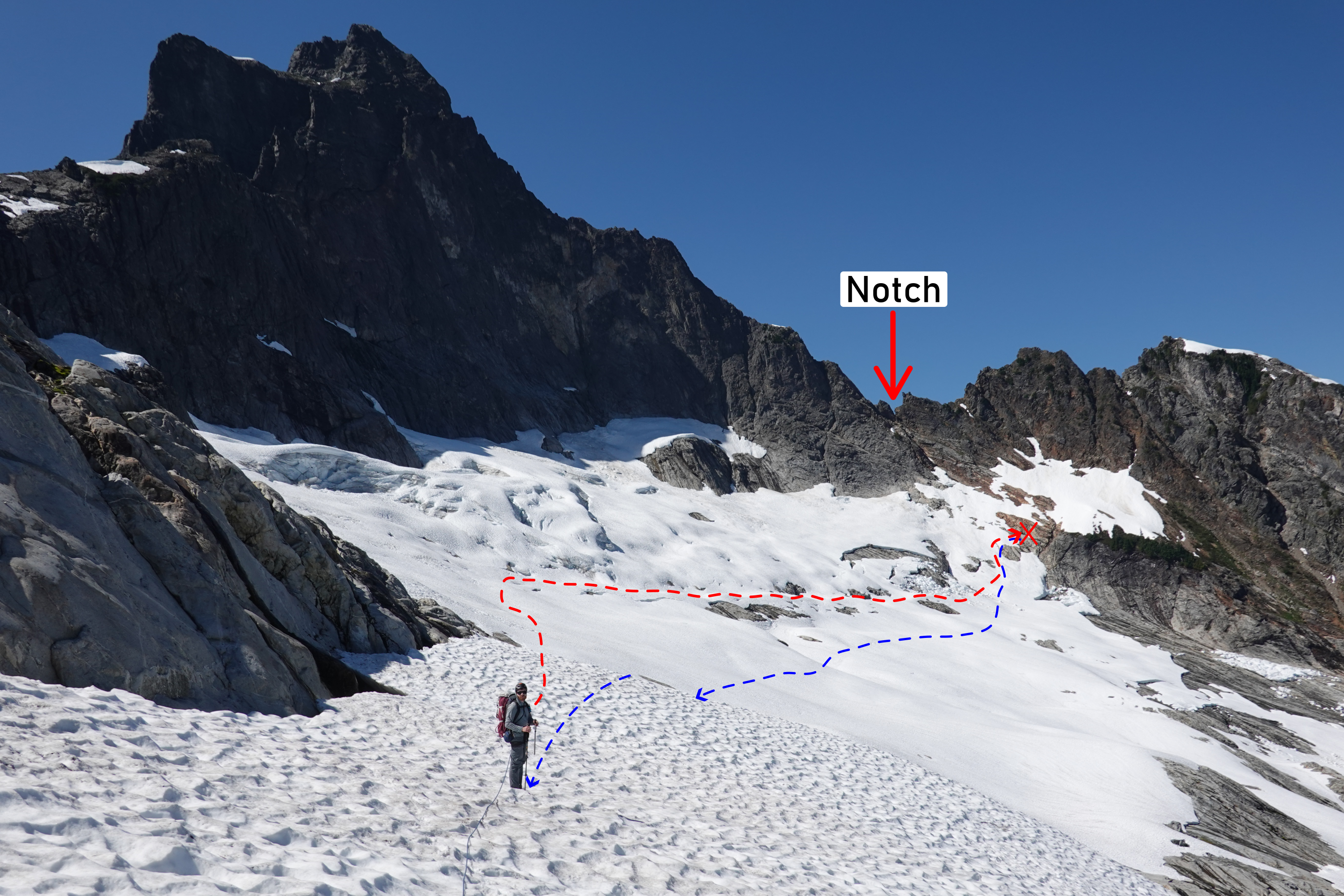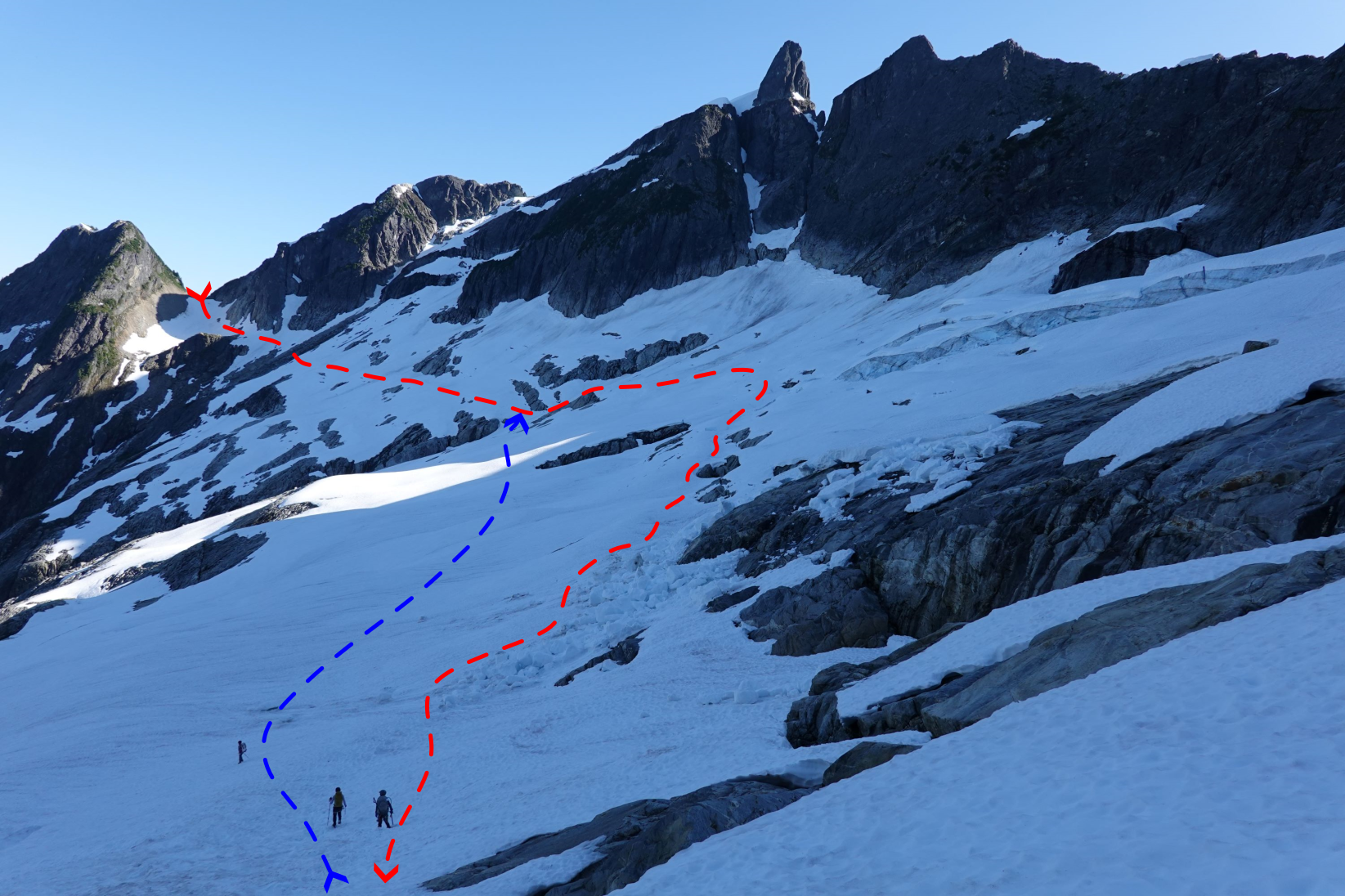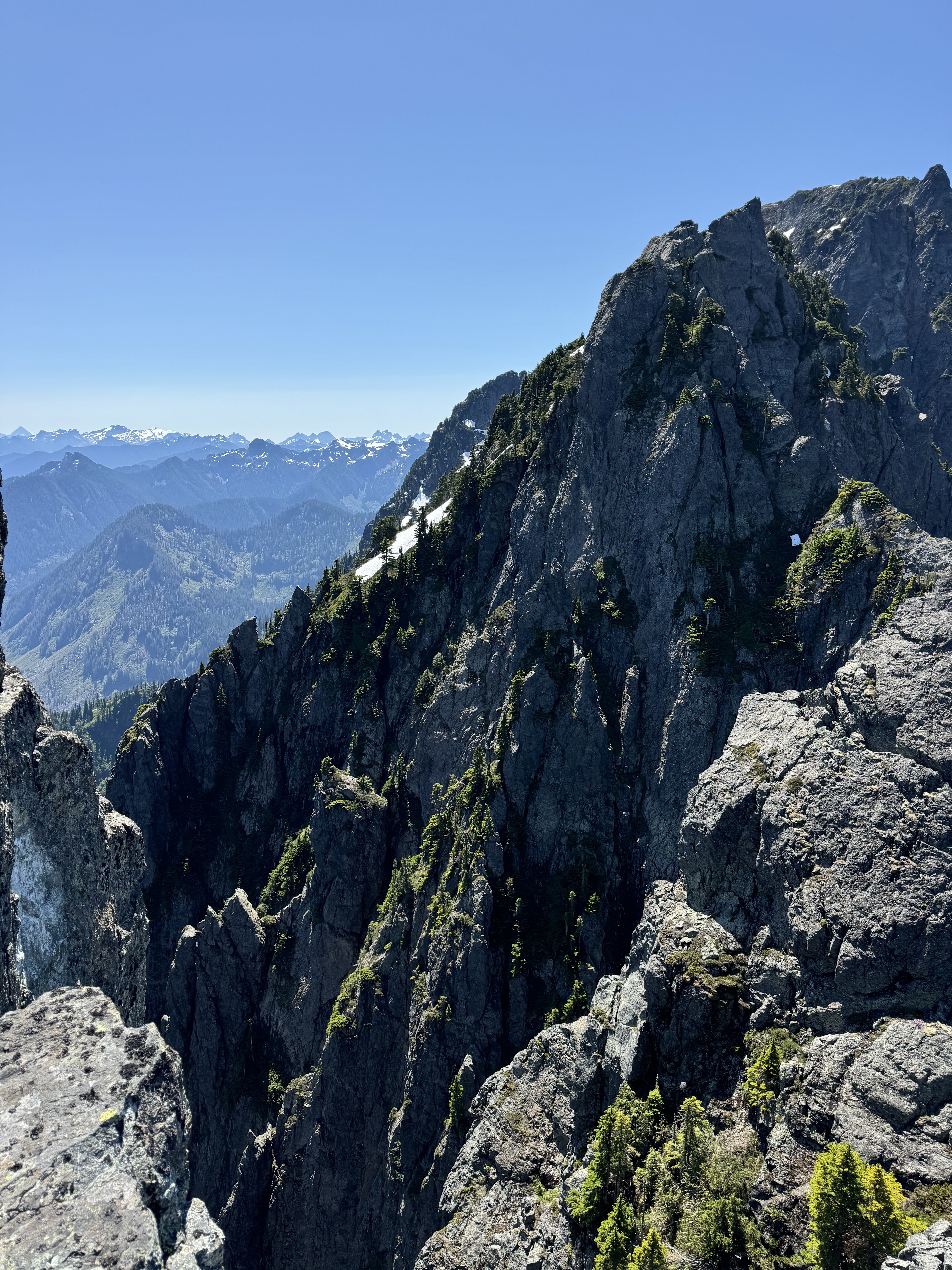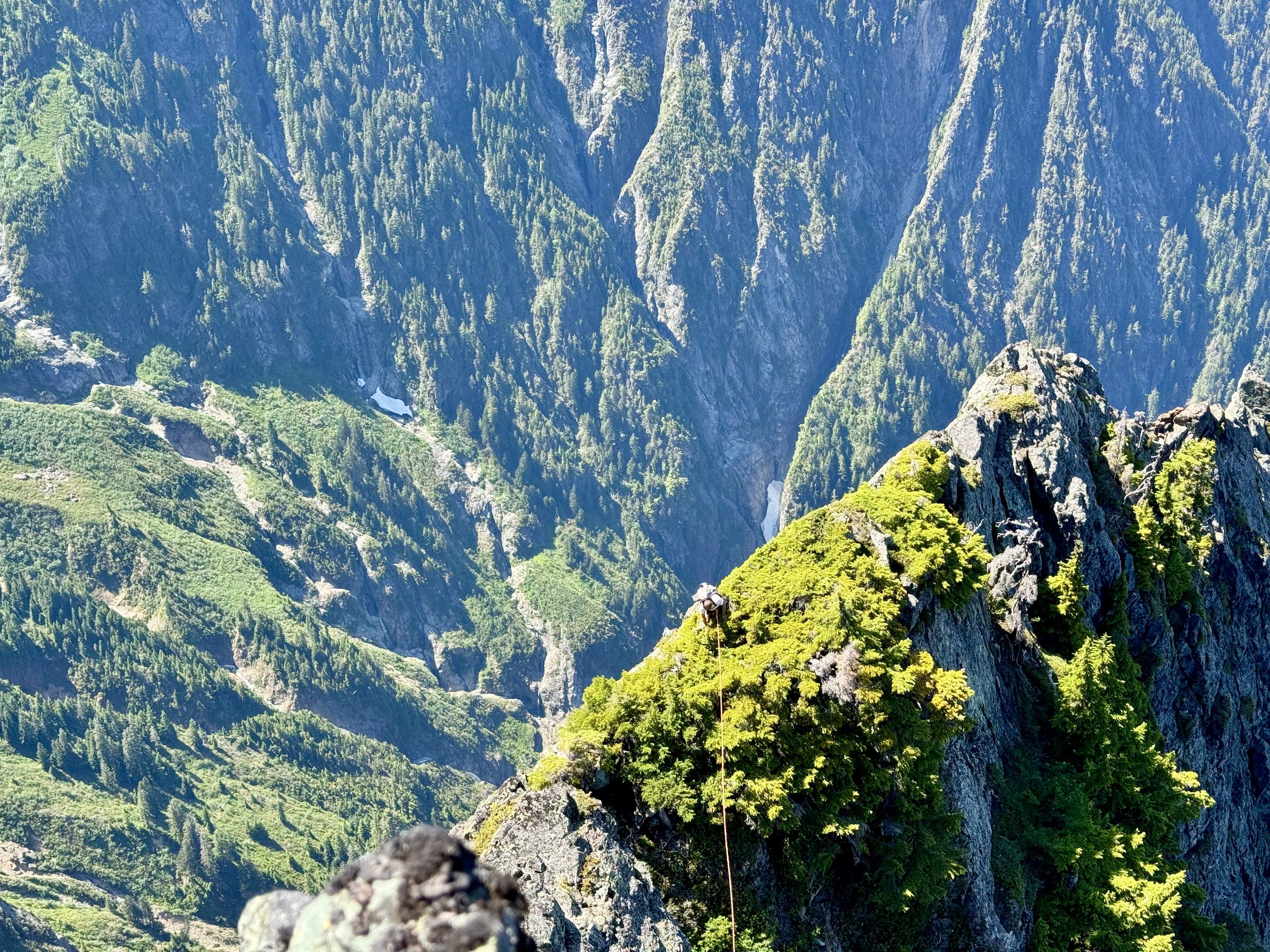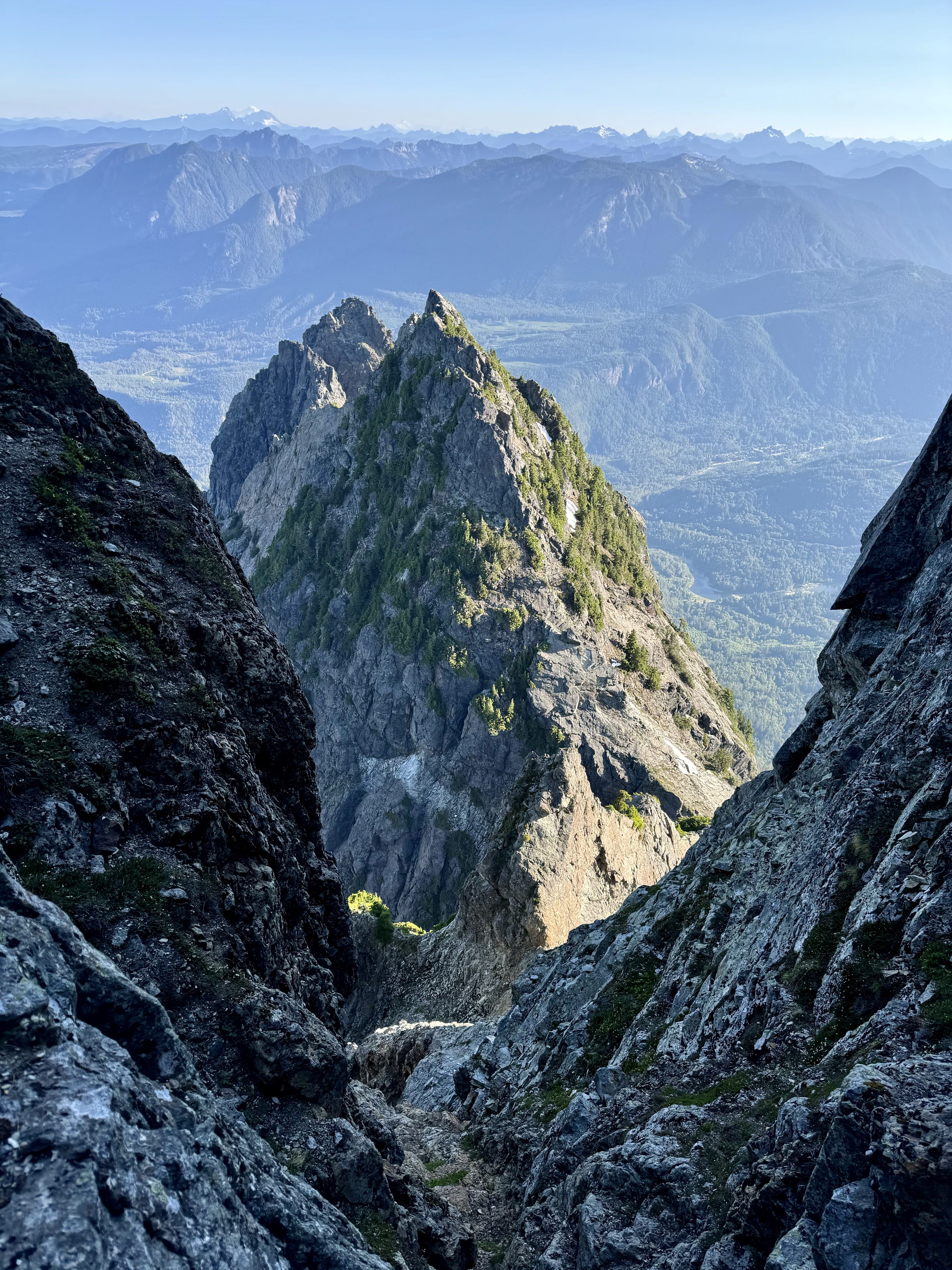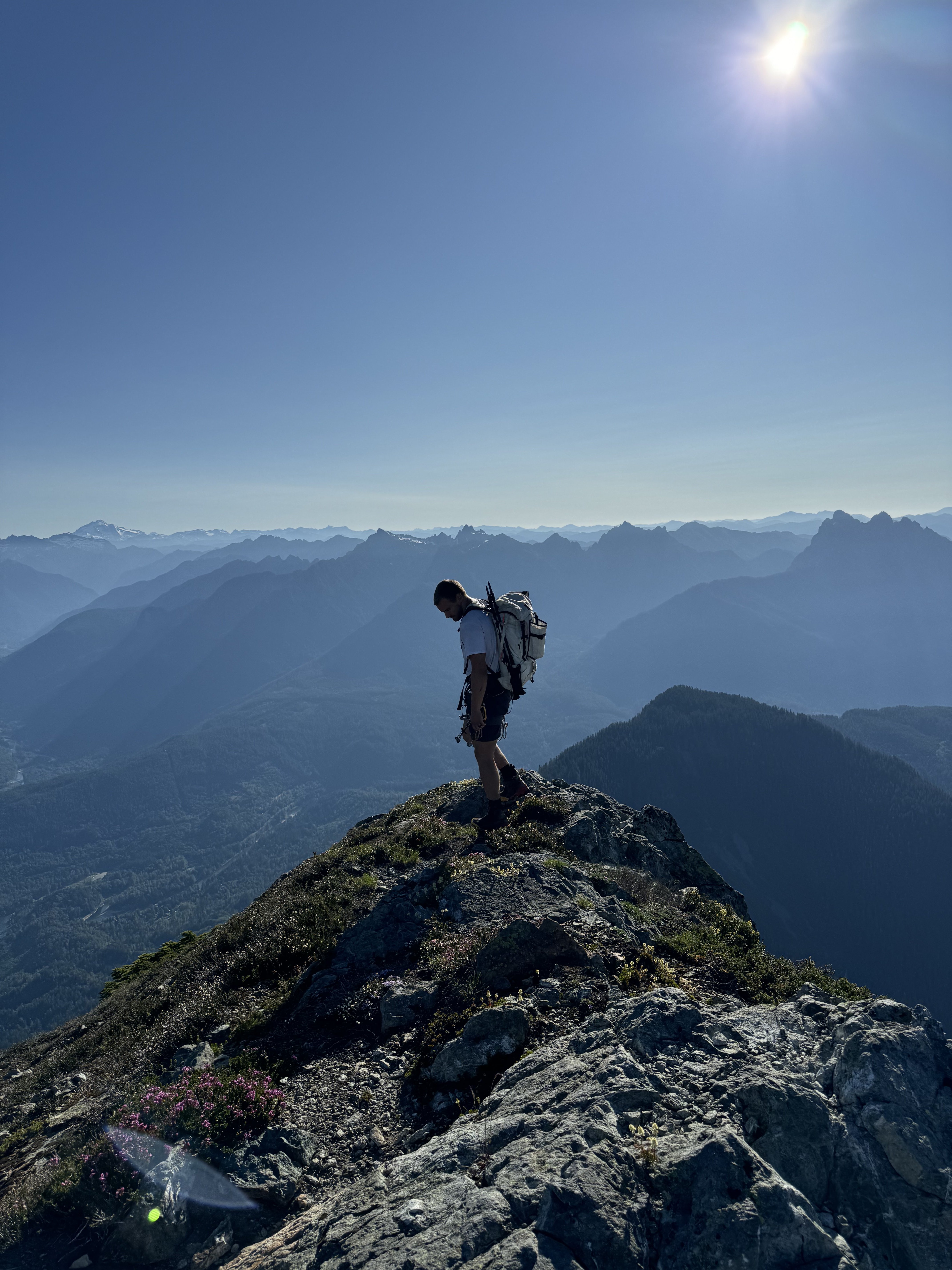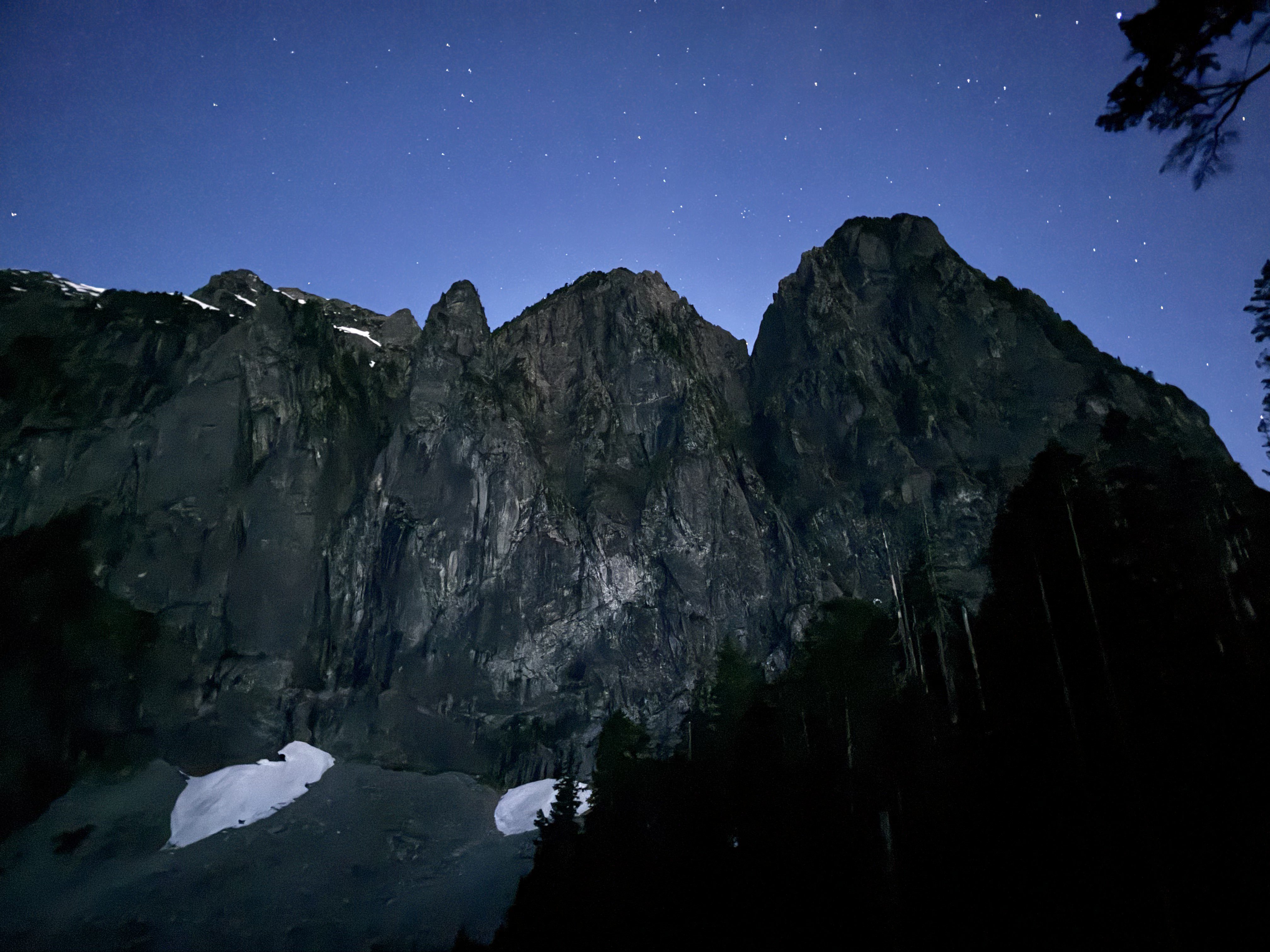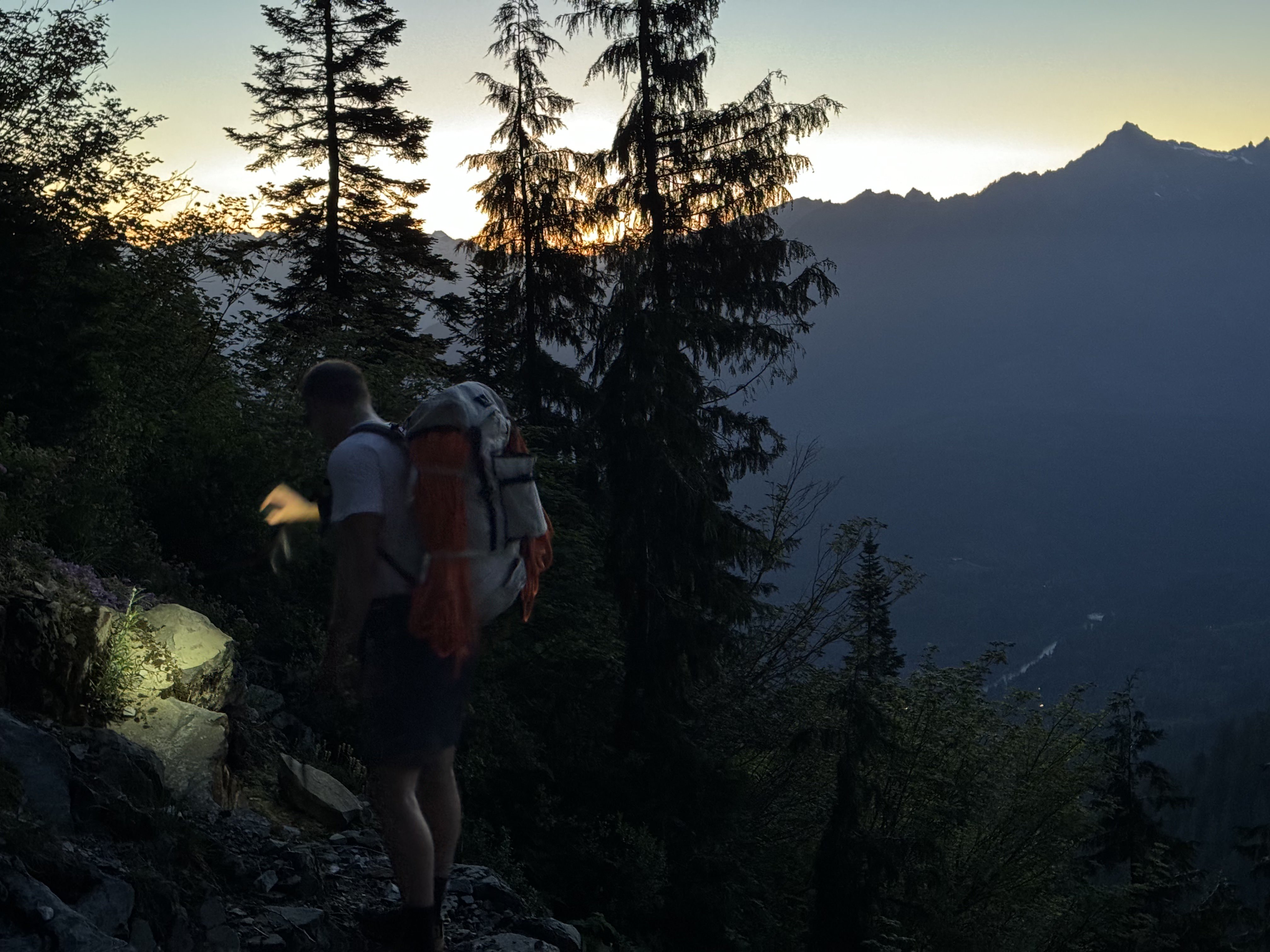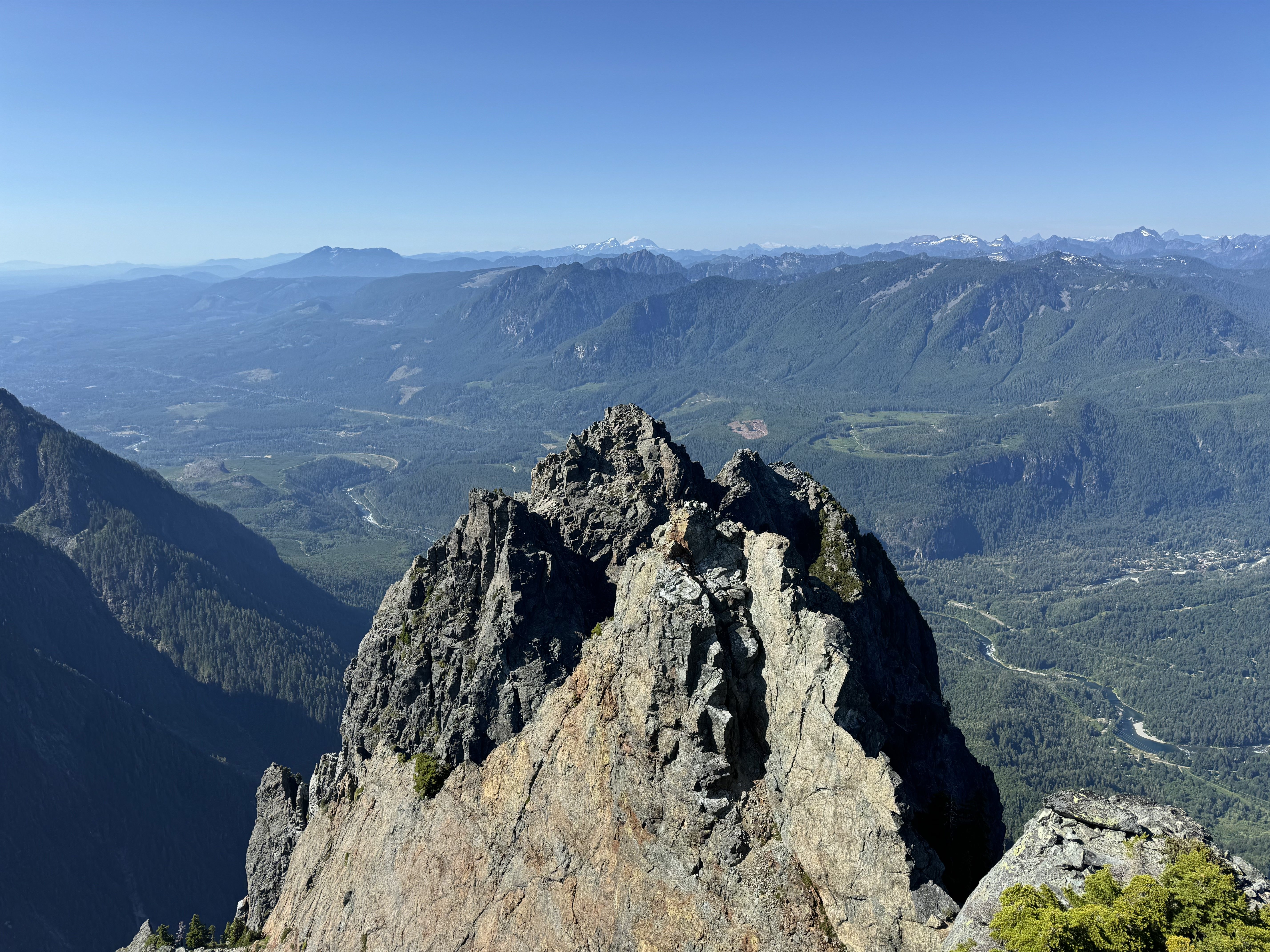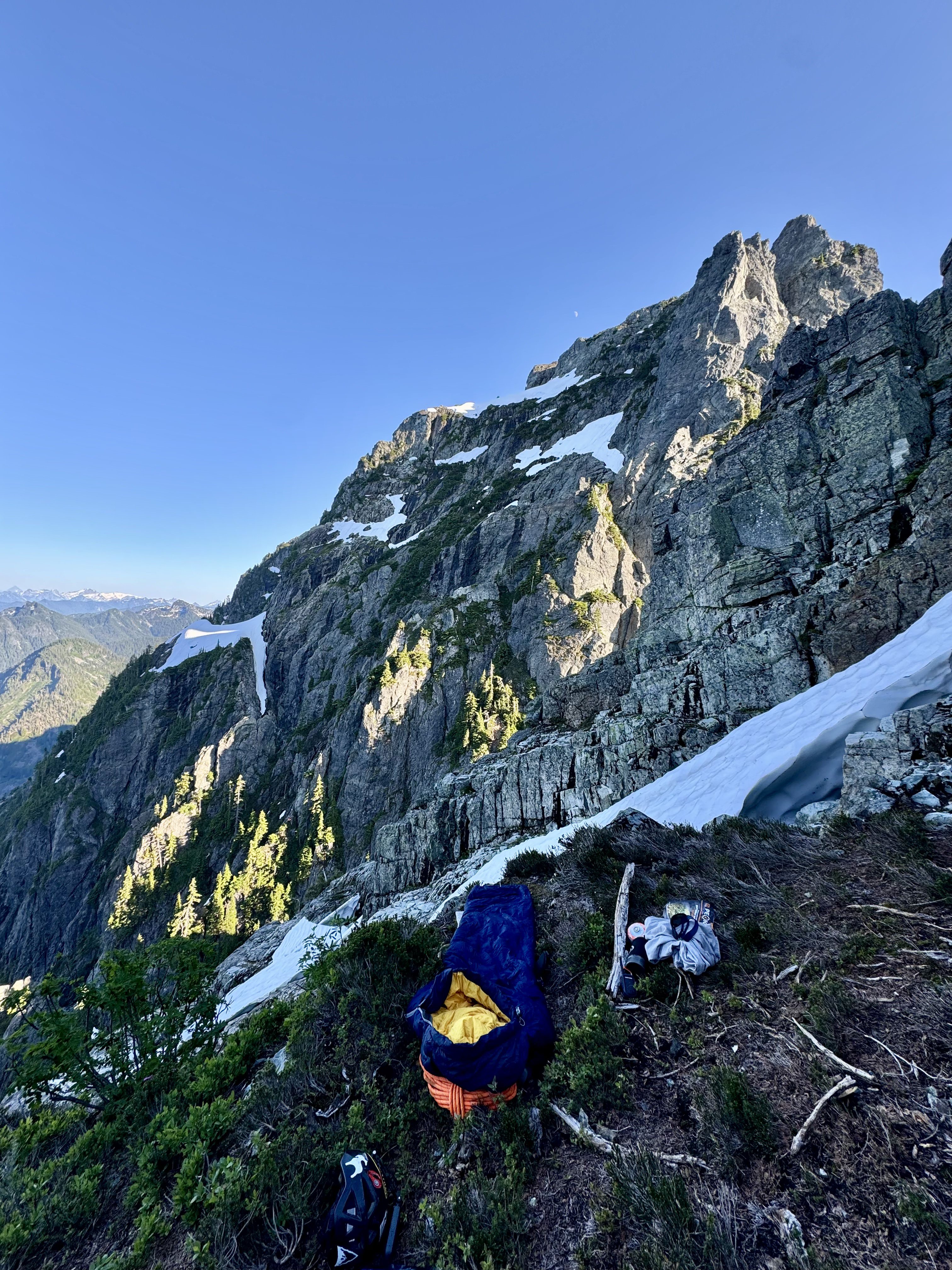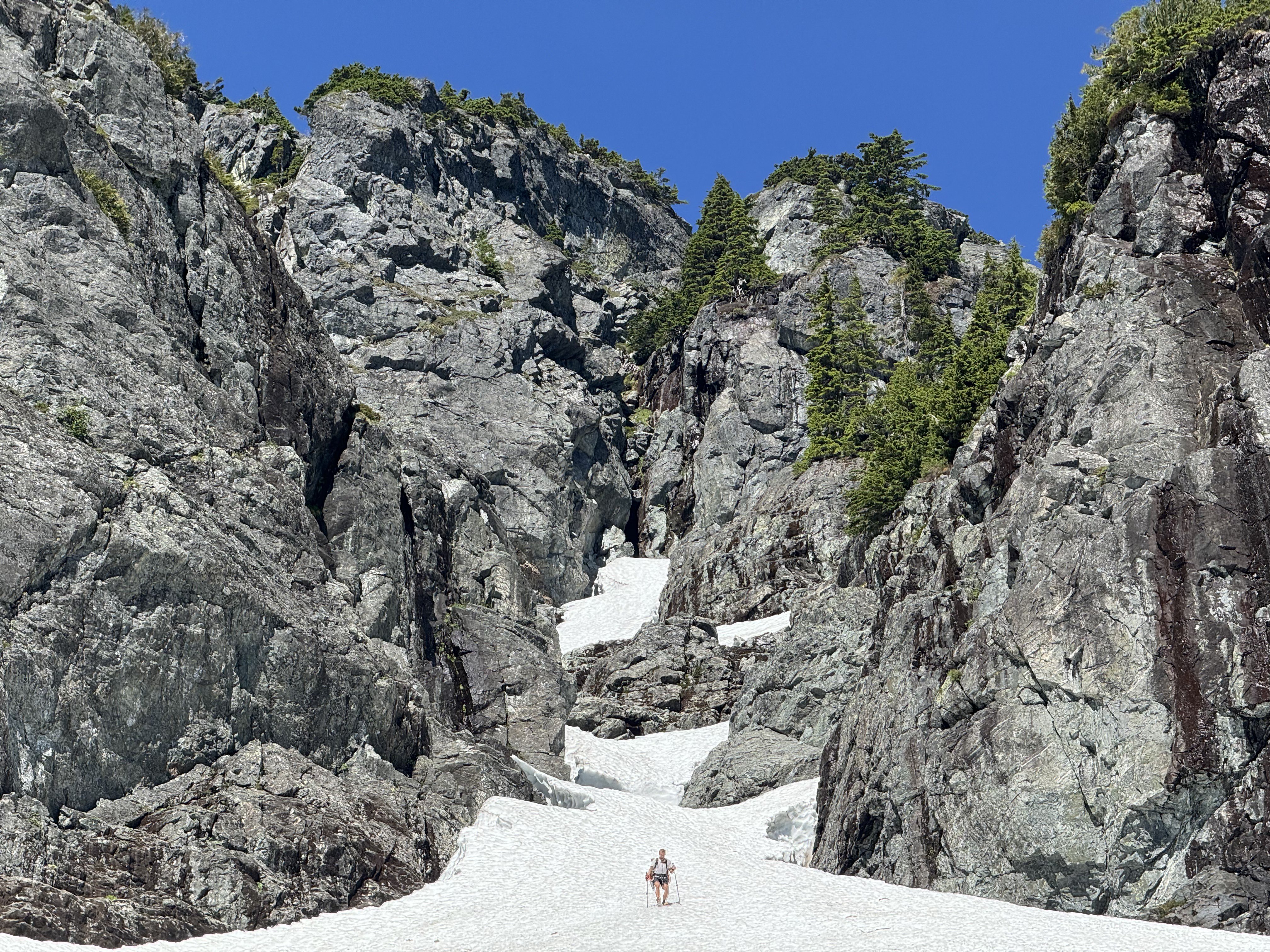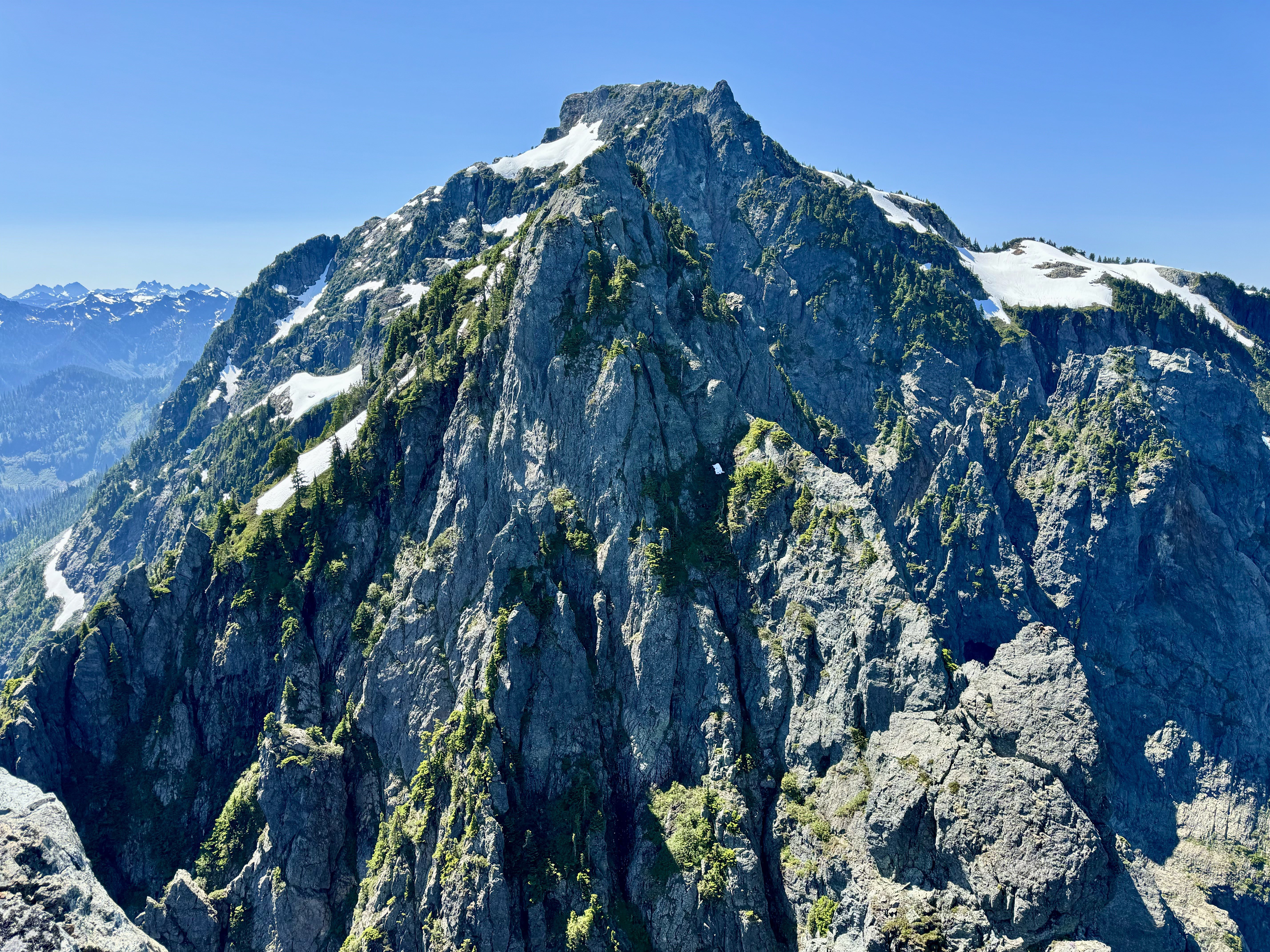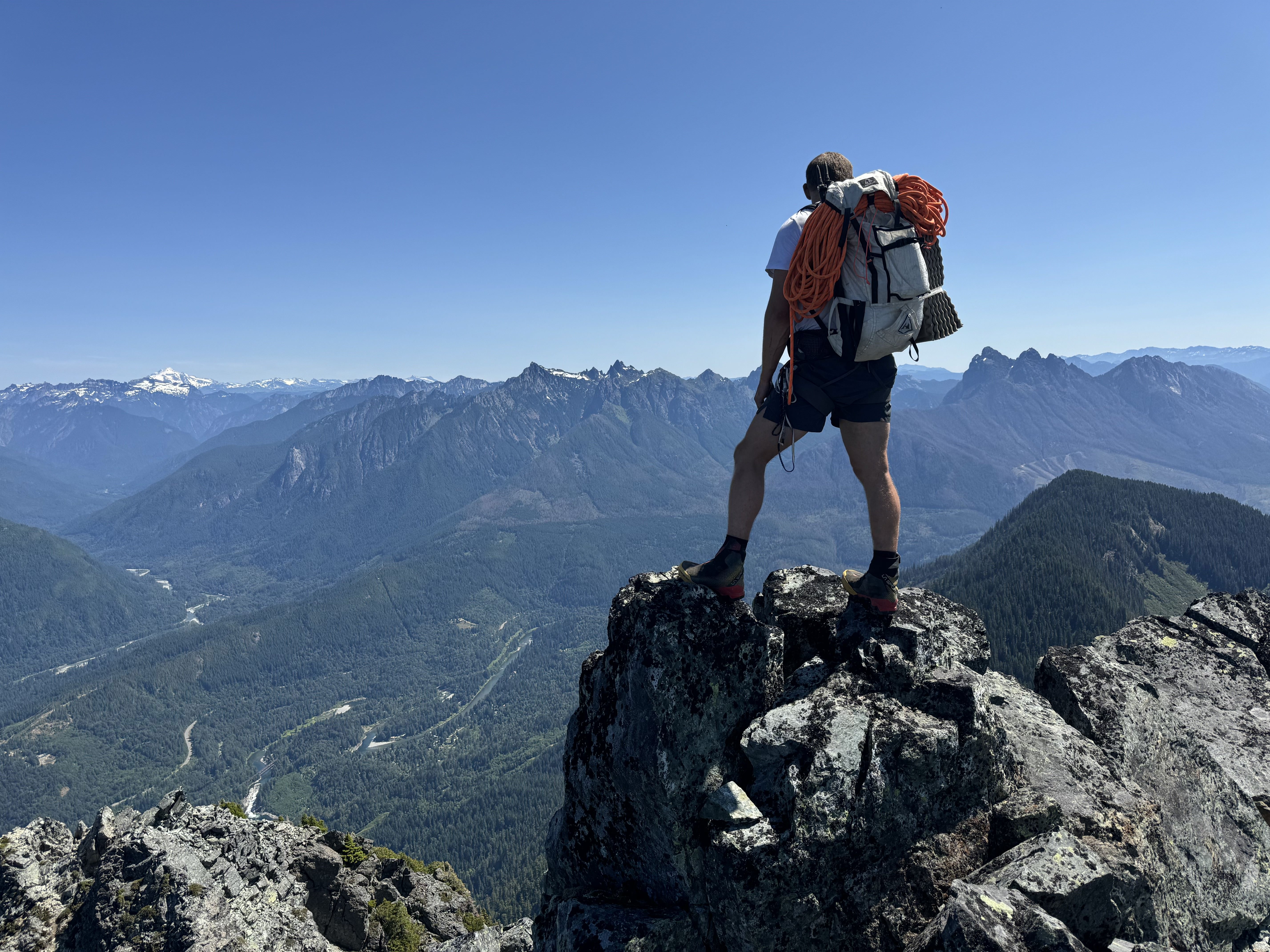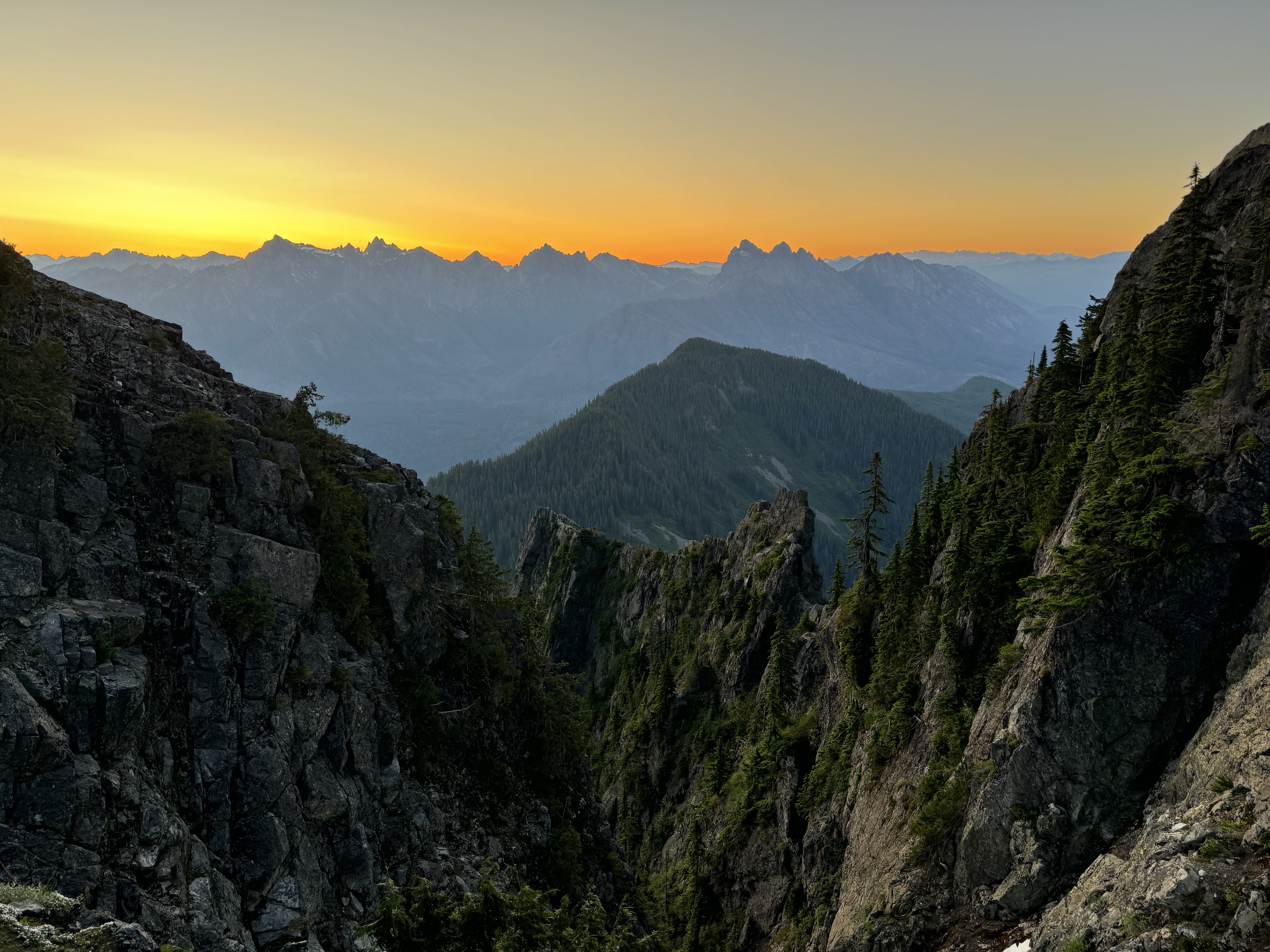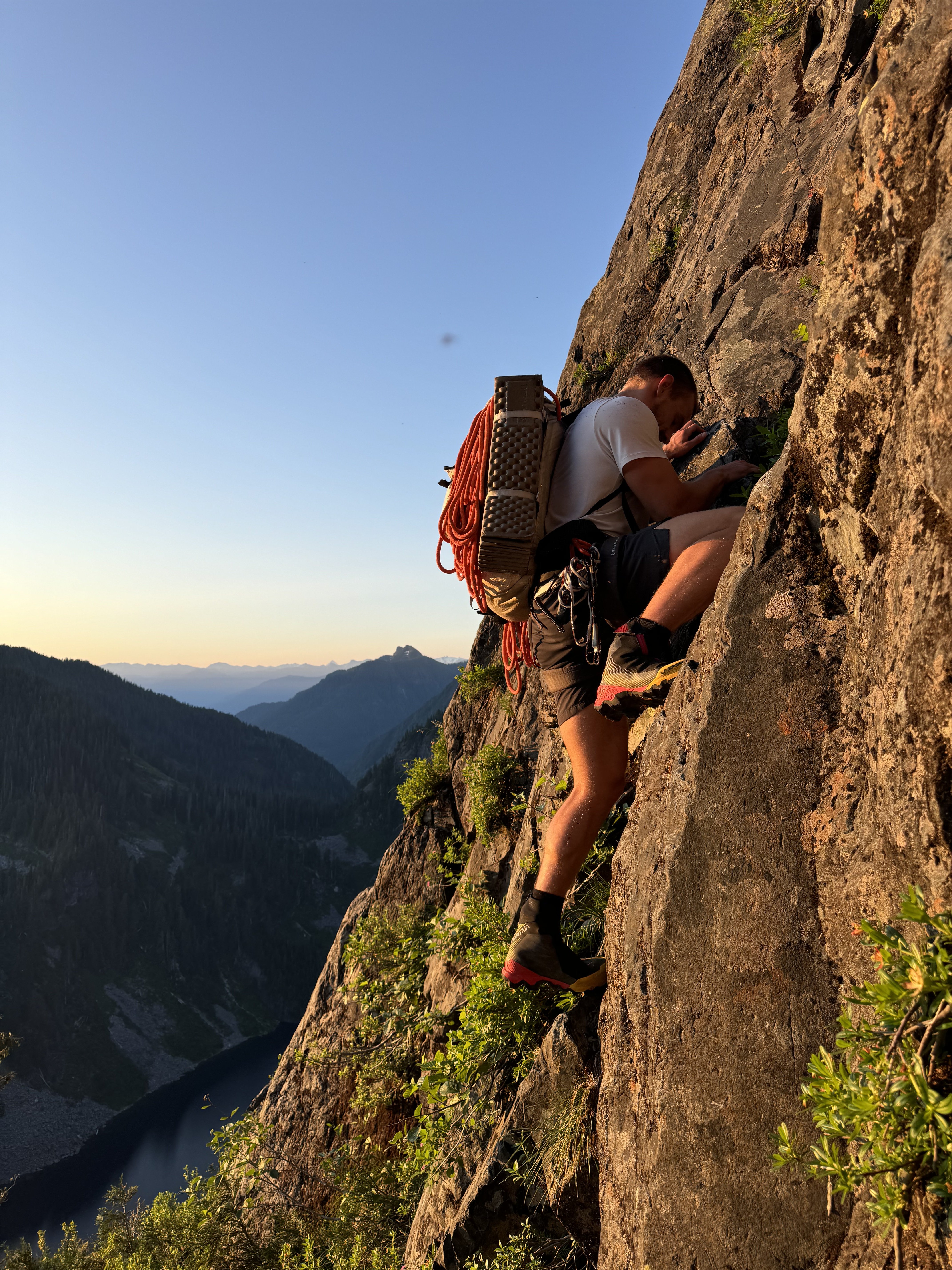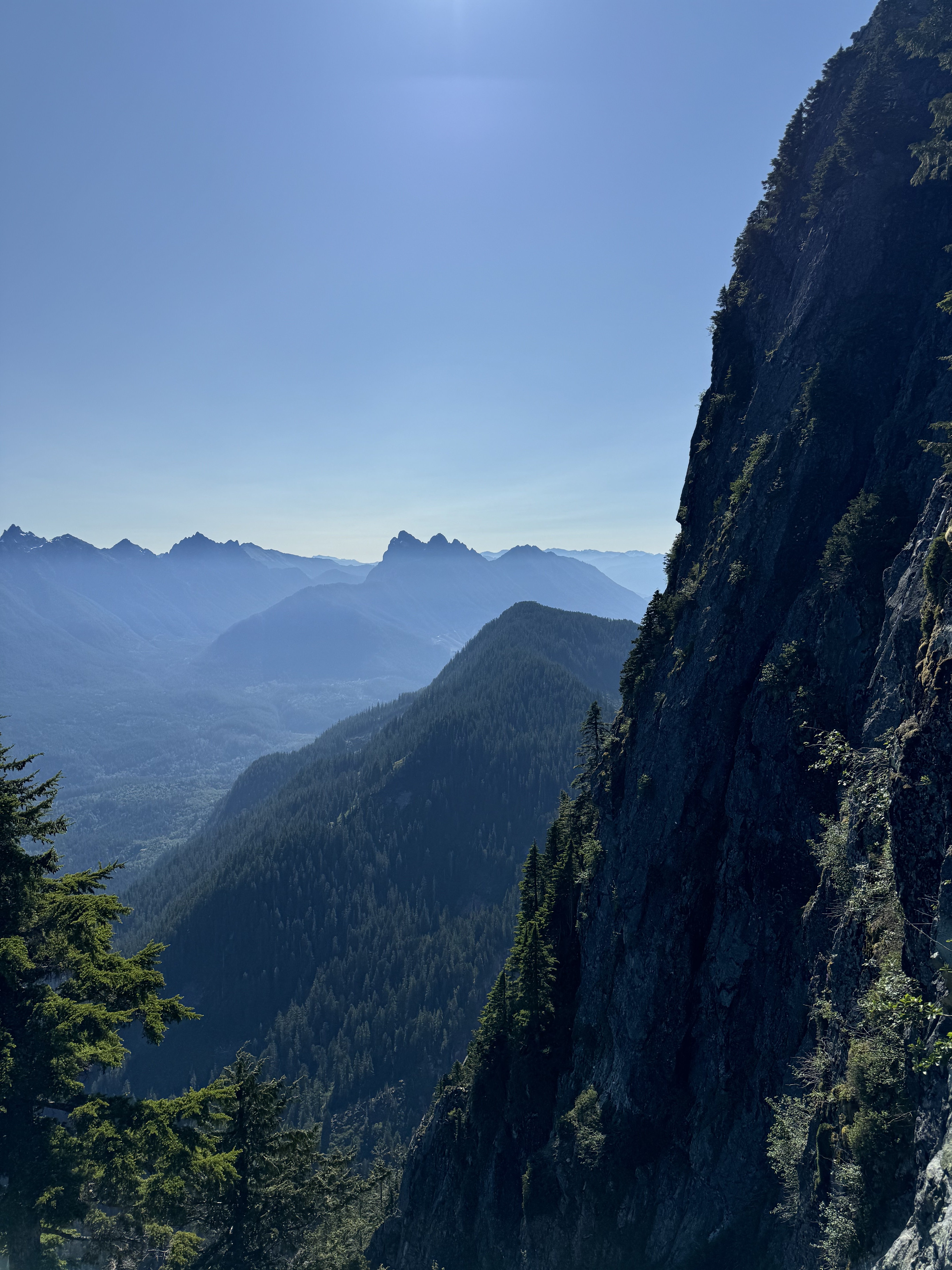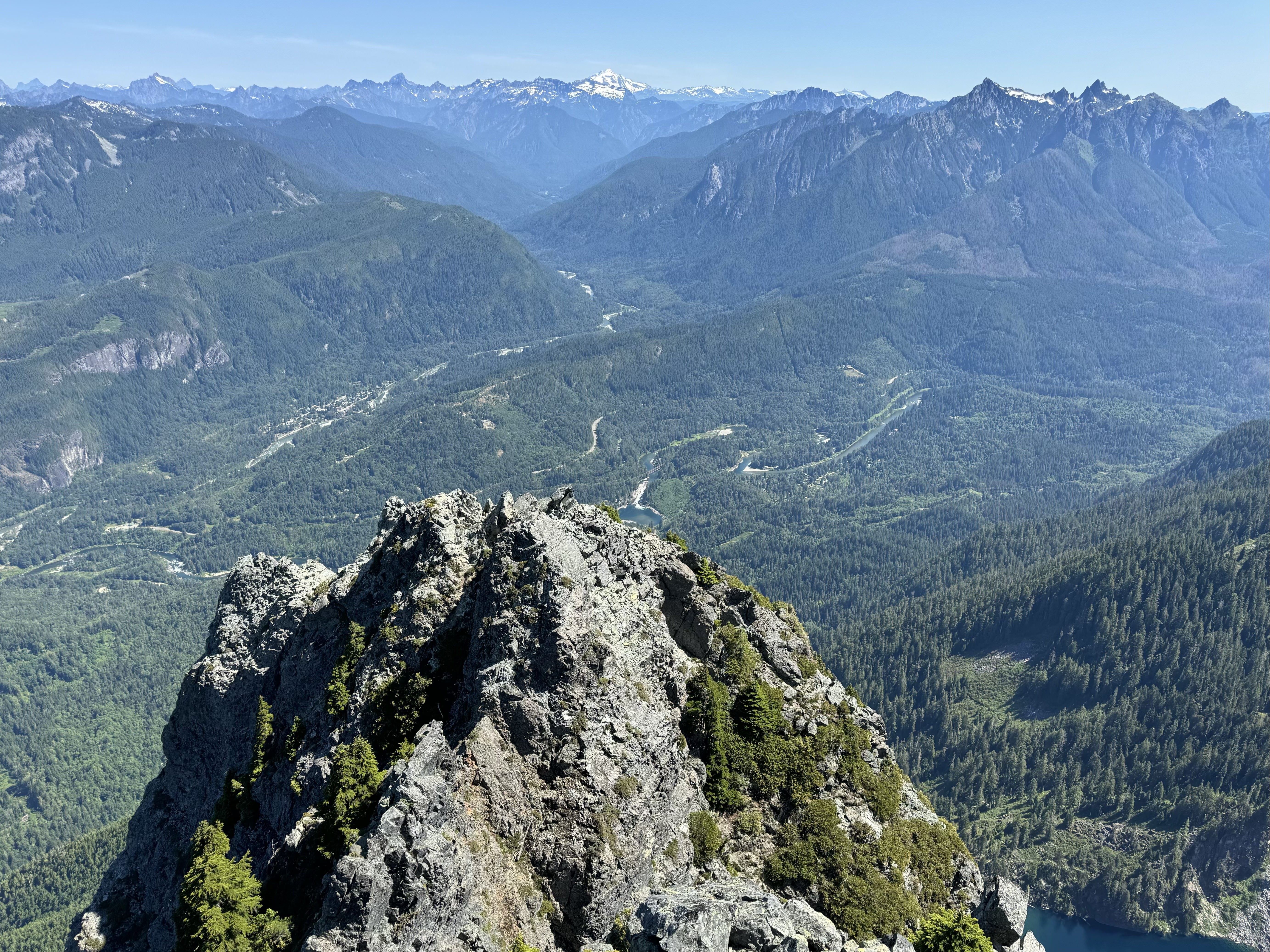Leaderboard
Popular Content
Showing content with the highest reputation on 07/16/24 in all areas
-
Trip: Inspiration Peak - South Face Trip Date: 07/14/2024 Trip Report: Me, @Albuquerque Fred and Mike climbed the south face of Inspiration Peak over two days July 13 and 14. We also walked up Glee on the way to camp since Inspiration in two days wasn't enough exercise for them. For beta we had @JasonG's TR: and @Steph_Abegg's beta, although I thought her suggestion to go past the base of the gash was crazy. We did so and it involved an insanely airy step across where the ramp disappears briefly just past the gash, then you climb up just to go back down to just above where you were before the airy step. I say go up the ramp to the gash, then go up, easy. This photo of Steph's was gold: The camp is melting out with about 5 good sites available and dry. We had excellent conditions on the glacier, easy navigating up a direct line, then a walk directly onto the approach buttress where we left the snow gear. A pitch, then simul traversing, up the ramp, up the gash, to the top. Easy route finding. We did like 12 or so raps with a tiny bit of down climbing right back to our snow gear. Many of the raps are tough. The big block to start the South Face raps has quick links going both directions, with additional stations below both ways. We went more westerly off the block but it was a hard steep traverse at the bottom of the rap to get to the next station. What have other people done here? The climbing was, I thought, great in the gash. A good, tough route to a tough peak. Crazily enough the mountain was getting tons of action this weekend. We talked to a group that did the east ridge the day before, another that did the south face, and then on the hike out another going for the east ridge on Monday. We were stupid and hiked out on the same day as the summit. Around 14 hours camp-summit-camp, 20 hours camp-summit-car. +2.5 home. Ew. In bed at 3:00 am with a 5:30 alarm for work. The trail: In camp: Fred finding the direct line through the glacier: Easy moat: On the summit, beautiful day: So happy to be on dirt again: Terror Basin conditions from Glee: Gear Notes: Single Rack to #2, 2 30m half ropes, crampons not really needed but used, rock shoes. Approach Notes: Grueling to camp, easy from there.3 points
-
Trip: Mount Triumph - NE Ridge Trip Date: 07/13/2024 Trip Report: TLDR: The snowfield crossing to the NE Ridge still has significant objective hazards. I would expect hazards to be similar for a little while longer before enough snow melts/sloughs off that the risk is minimized. I believe I can claim the first trip report of Mount Triumph in 2024. Sadly, I can’t claim the first summit of the year. I was a part of a team of 4, and our plan was to climb Mt Triumph over 2 days, camping at the bivy site 2 pitches up the start of the NE Ridge climb. Our timeline was as follows: Depart Seattle Area 4:00 AM Leave Thornton Lake Trailhead 7:15 AM Reach the first Thornton Lake 10:15 AM Arrive at the top of the Saddle above the 2nd Thornton lake. 2:00 PM Arrive at the base of the notch 3:45 PM Departed the base of the notch 5:15 PM Returned back to the Saddle above the 2nd Thornton lake. 6:15 PM Back to the trailhead 11:15 PM Conditions on the way to the climb: -The trail up to the first lake is well maintained -The trail to the 2nd lake is a little bushwacky, but there is a defined trail up to it -There were a couple creek crossings, all were manageable (trekking poles were nice, but not required) -After the 2nd lake, you need to cross a boulder field that then transitions to heather/scree as you go up the col to the saddle above the 2nd lake. I’d recommend hugging the cliff to climbers right as you go up; the heather is easier than the loose rock and there is a faint trail to follow. Above the heather you get into much more loose rock, and though manageable, it becomes rather difficult to avoid dropping rocks on team members below you. -For the time being, there is still plenty of snow and running water nearby this saddle if you plan to bivy here. -The snow crossing was by far the most challenging part of the approach. After reviewing the objective hazards for a bit, and debating the best path, we opted to follow relatively closely to what I had read most trip reports follow, which is along the bench that leads to below the notch. Only one part of the bench showed any signs of recent snow/ice fall, which was unfortunately at the end, where we couldn’t travel too far below it since we need to start going up the face to get to the notch. We opted to move as fast as possible to minimize our time in the hazard zone. Even trying to minimize exposure, we still had a bit of excitement as some snow blocks broke off while our last team member was under the main hazard zone. Thankfully the snowfall behaved as we expected (if it were to fall) and stopped short of our crossing path. So the team member wasn’t in direct danger, but it certainly looked like it, and in the process of trying to get out the way, they unfortunately sliced their leg with a crampon. We took a break on a rock outcropping directly below the notch to bandage up the leg, and decide what to do. We decided the injury was significant enough that we didn’t want to spend another day on the mountain, and planned to make the descent back to the trailhead. We had dinner on the little rock outcropping, and spent the time re-evaluating our path on the snowfield. We saw one more exciting ice block fall, this time off the old glacier. This block made it all the way down to the bench that we crossed, and because of that, when we headed back we decided to traverse below the bench to better stay out of the path of any potential snow/ice fall. The snowfield was shaded on our way back, which helped with snow/ice fall risk. Also worth noting, the mosquitos were bad on the way up in the heat of the day, but were downright miserable on the way back; didn’t matter if we were stopped or moving, they followed us relentlessly. DEET had a minimal impact, I’d recommend bringing a bug head net. Lessons learned include: - We picked about the worst time of the day to cross the glacier (hottest/direct sun). Unfortunately, if you are trying to do Mt Triumph in 2 days, it’s very challenging to avoid crossing this snowfield mid/late day; your best bet is to wait for the sun to dip below the peak of triumph and cast a shadow over the snowfield, which happened around 5:15PM for us. You can push the first crossing to early in the morning day 2, but that will just push back the 2nd crossing on the way back. -We opted to rope up the first time we crossed the snowfield. This was to have a chance of protecting against additional glide avalanches. But because we were roped up, the last person on our team spent the longest time under the primary hazard zone as the steepness increased significantly above that zone and those of us in the front of the rope team slowed down on the uphill. This is why we opted not to rope up on the way back 2nd Thornton lake, col you go up on right First good view of Mount Triumph and the snowfield you need to cross View of the crossing we took on the way out (red), and back (blue) based on our changed opinions of the biggest objective hazards. Red X is far as we got View of our path from the opposite side Gear Notes: -Crampons were quite nice for the snow crossing, even with the heat the snow had some spots on the traverse that were quite firm -Brought a decent sized trad rack, but I didn't actually use it (so can't give any feedback there) Approach Notes: GPS Track available on Peakbagger: https://www.peakbagger.com/climber/ascent.aspx?aid=2573855 I also shared a few more pictures on the PNW Peakbaggers Facebook page: https://www.facebook.com/groups/209335589972834/?multi_permalinks=15728438736219923 points
-
The traverse of Mount Index has been on Ian and I’s radar for over three years. It summits two of WA’s supposed “Difficult 10” peaks in one fell swoop, and has a legendary reputation in the WA climbing community. I first heard of it when I stumbled across the Difficult 10 list online. The climb immediately got my attention, but at the time I did not think I would ever have the skills or the partner to complete it. The exposure and route reports were pretty terrifying and looked so far beyond anything I had done up to that time. The route is very aesthetically pleasing, and can be seen from the highway. There are a few trip reports for the traverse online, most done by blue-collar legends of the WA climbing community. There is also Colin Haley’s report of doing the traverse in 24hrs in winter, which seems super-human to me at this point. Unsure of the technical difficulties that would be involved, we wanted two full days for the climb to increase our chance of success. Ian and I left my house at 1am Sat morning 7/13. We were hiking up towards Lake Serene by 2:30. At the lake, we followed the convoluted trail towards the West rim of the lake, then veered upwards for some bushwhacking until we reached the talus slopes. We followed them up towards the North Face of the North Peak until we reached around 3,300’. At that point we scrambled up easy but unstable red rock until things got bushy. There are rap anchors everywhere on the North Face from so many people bailing, and it is very hard to tell if you are going in the right direction. Ian and I basically foraged upward through very steep brush until we reached the saddle of the huge and distinctive gendarme feature. From there, we realized we were too far East and had skipped most of the easy “open bowl” section. We downclimbed slightly and traversed West into the hidden gully that becomes obvious at the top of the bowl. This easy gully led us straight up to a notch at the start of the North Ridge at 9am. The sun hit and it went from hot to very hot. The forecasts for the summit were in the 70s, but I did not believe it before we left. The rib climbing is super fun as stated in other trip reports and is around 5.5. Ian led the first section then we simuled up to the upper slopes where the brush begins again and a large snow patch is located. We were soaked in sweat and already dehydrated at this point. We melted and ate a meal there, then continued up some very vegetated terrain to the North Peak False Summit. From there it is a short and VERY exposed 4th class scramble to the North Peak. We arrived on top at noon feeling a bit fatigued but confident we could make it to Middle. We both agreed that North Peak by itself is quite a bit steeper, more exposed, and difficult than Johannesburg Mountain, to which it is often compared. After the North Peak summit, the traverse becomes even more exposed. There are massive cliffs on both sides the entire time, and even when the terrain is moderate near the ridge crest, there are still massive cliffs just below those slopes with nothing to catch you from falling. From the North Peak, we followed Riley81’s trip report on CascadeClimbers.com. His is one of the most helpful trip report for any climb that I have come across. Very concise and clear directions that made sense when we were on route. We downclimbed a bit from the summit, then made a rappel, then climbed back up to the East side of the ridge, then back down a long loose gully, then another rappel, this time overhanging, down into the North-Middle notch. A bit complex. At the notch, I finally grasped why the Middle Peak has such an intimidating reputation. Once you make that rappel, the easiest method of rescue is to finish the traverse, which is not easy even from that point. A helicopter rescue would be very difficult as well, and they would have to long-line you out. It feels like you are in a completely different world, with HWY 2 and the busy Lake Serene Trail at your feet. From the notch Ian led the technical crux pitch of the route. A full 60m gully with a few 5.7 moves. Ian led his way up like a champ and I grunted my way up like a chump. At the top of this gully we were on the ridge crest, and we simul-climbed 3 pitches to the false summit of Middle. We were totally out of water at this point and very thirsty. Luckily, we could see a snow patch ahead. We made a very overhanging rappel and made a beeline for the water source. We cruised right by the bivy site without even seeing it. We melted more snow, ate some snacks, then summited Middle via easy heather scrambling. At the top, we both agreed why this is at the top of the Difficult 10 list. The climbing on the peak itself is not terribly hard, it is more due to the amount of effort it takes to get there. I called Maddy to check in from the top around 4pm. Ian and I discussed going to bed, but we still had 6hrs of daylight. We started the complex descent from Main Peak by following the ridge crest and deviating to the East to downclimb a ~200’ long gully. From the bottom of this gully, we climbed up to the ridge crest via another gully and over to the West side. We then descended some easier slopes to a small gendarme where we crossed back to East side of the ridge. More complexities. There are some white colored slabs with snow, and a few vegetated sloping ledges. It was just after 6pm when we reached said ledges, and we were worried about the time/energy to reach Main Peak that day, as well as the availability of bivy sites at the Middle-Main notch (there were none). We brewed up and I spent 6hrs sweating profusely and trying to sleep on an angled 10 degree slope with swarms of mosquitoes targeting my exposed face all night. I somehow drifted off around 2am and awoke to Ian climbing down to my ledge at 4:45. I had overslept our 4am wakeup, and my punishment was skipping breakfast and just eating a Cliff bar. We were on our way by 5am after filtering water. We down-climbed the white slabs which were wet and sketchy, but they led us to a tree with a rap anchor leading down toward the notch. From the bottom of the rap it is a short scramble up and over a hump and down to the Middle-Main notch itself. From the Notch, Ian led again. The pitch was a shallow 5.6 gully, this time only 35m or so. Distinctly easier than the pitch coming out of the North-Middle gully. I quickly followed him and led the way up some steep brushy slopes while Ian flaked the rope. After 30min or so, we popped out on a ridge crest, which is actually the top of the South Norwegian Buttress. We simuled 3 very exposed but easy pitches to the “Wedge Gendarme”. From there we down climbed to a notch between the Gendarme and the North Face of Main Peak. From this notch, the route is actually quite obvious. The route up the face of Main is much easier than it appears at a distance, and we scrambled easy 4th class slopes until we were forced into the long red gully. We climbed in the gully for a few feet before starting the rightward traverse on a grassy ramp. After the ramp, a ledge takes you around to the West side of Main peak and the technicalities are over. It is a short hike up past the false summits of Main Peak to the top. We reached the summit at 8am Sun morning. We then put away the rope, ate a few snacks, and walked east to the top of the Hourglass Gully. At the top of Hourglass, we were about to make a new tree anchor when Ian found a new-ish sling already there. We rappelled down the first waterfall getting a bit wet in the process. We then pulled the soaking wet rope and made a second rappel on our own new tree anchor to the steep snowfields below. We then spent about an hour baking and slowly down-climbing the sketchy snow. Neither of us had an ice axe, and Ian didn’t have crampons. A light axe would probably have been worth the carry. After a short rock section, I found another tree anchor and made a full rappel down another waterfall and got completely soaked. This rap led to another very short rappel onto some less-steep snow. We glissaded down to the bottom of the snowfield, then picked our way down through the trees until we could make the traverse to the East Ridge route. From there, we stayed exactly on the ridge crest and proceeded with the hard-core bushwhacking descent for around 1,000’. My shorts and T-shirt were not very useful and my arms and legs got shredded by the spiky vegetation. Once at the saddle above Lake Serene, we descended towards the lake on boulders staying left to avoid vegetation as much as possible. As soon as we got to the lake I took off my boots and jumped in with my clothes on. My shorts and T-shirt were disgusting and the water felt amazing. After that we filtered water and made meals. Around 1pm we started our way around the lake. Around 2pm we walked past all the crowds of Seattleites at Lunch Rock. We were back to the car by 3:30pm and home by 5pm. My opinion is that this is a very good route. The traverse style, exposure, and amount of work required make it classic, and the proximity to civilization makes it unique. The climbing itself is a lot of work, but that is Ian and I’s specialty. I would recommend this route to any experienced climber in WA looking to test their abilities. It is certainly harder than any other route we have done so far in the state, with the Price Glacier + Noocksack attempt coming to mind as our other long effort. I am very satisfied to have this one done, and from now on my trips over HWY 2 will bring a sense of accomplishment, rather than anxiety. GPX Track: https://www.alltrails.com/explore/recording/afternoon-hike-6ecbdd6-436 Gear List: https://www.packwizard.com/s/Q0Fbxc12 points
-
Trip: Mt. Fury - Wayne Wallace’s Mongo Ridge (Second Ascent of the Rooster Comb and new line on the Pole of Remoteness) Trip Date: 07/07/2024 Trip Report: Once in a Lifetime: Wayne Wallace’s Mongo Ridge (Second Ascent of the Rooster Comb and new line on the Pole of Remoteness). VI (26 Pitches, Steep Snow) 5.10a+ R. [not to dispute or change the current ED 1 5.9 rating, proposed by Sam Boyce. A note on the grade: 1. we encountered climbing harder than 5.10a on tower one--this could be avoided with better route-finding 2: Wayne gives a grade of 5.10 on tower three with the description of an "overhanging bulge" that matched our experience. We are in agreement that there are multiple ways of lowering the technical climbing difficulty, as Mongo Ridge is itself full of lines, and are quite honestly not concerned with the naming of difficulty or grade. The experience is full on, and the "hardest" pitches usually get low technical grades--5.4 Tower 3 traverse.] 65 hours on the route (30+ hours of climbing and three bivys), 6 rappels, 3 simul pitches, 1 big bag of Chad’s Backcountry Catfood. Adam “Mo” Moline & emilio Taiveaho Peláez Itinerary: Monday July 1st: Drive and boat-in, walk to Luna Camp Tuesday 2nd: Luna Camp up Access Creek Wednesday 3rd: Below Luna Col to ½ way up Tower One (travel low route, below Luna Ridge, summit Fury, descend; sleep at tower one bivy) Thursday 4th: Tower One, Tower Two, Tower Three; sleep at tower three bivy Friday 5th: Summit of Tower Three to False Fury Bivy (climb Tower 4, Rooster Comb, Pole of Remoteness) Saturday 6th: False Fury to True Summit of Fury, traverse back through East Fury and back to Luna Ridge Bivy Sunday 7th: Luna Ridge down Access Creek and hike back down Big Beaver to HWY 20 Concise Version: A celebration of Wayne Wallace’s achievement on soloing the mythic Mongo Ridge. A rare opportunity and ideal weather window, following the wake of a week spent in the Chilliwack range for the wedding of a lifetime. Adventure, friendship, gratitude, the closing of a four year project, renewed vigor and commitment to wildness and to the power of cooperation and trust. Our line up The Pole of Remoteness (“Once in a Lifetime” 2 Pitches, 5.9R) is accessed by climbing the Rooster Comb and rapping climber’s left of the formation, then following an upward gulley to an opening near the base of the Pole before traversing onto the ramps comprising its south facing aspect (see P.24-25 for additional details/beta). Thank you to Wayne Wallace for the line. The boldness and grit of onsight free soloing Mongo Ridge, only rope soloing the hard climbing of tower three, is astonishing. Words fail in capturing the admiration we feel in imagining being on the ridge without beta, committing to each challenge--each tower, each pitch, each move--without certainty of outcome. As we mention in the trip report, our effort is but an echo of that awesome event in 2006; thank you to Jeff and Priti Wright for their second ascent and trip report (this trip report motivated us to attempt Mongo for the first time in 2022, and we’ve poured over it for years); thank you to Lani Chapko and Sam Boyce for the third ascent beta–including the idea to luxuriate on Tower Three, the “sick bivy” was indeed the sickest bivy of my life–and thank you to them for their second ascent on the Pole of Remoteness, for cleaning our rap tat during their climb (and a cam I think?); thank you especially to Jake Johnson, secret hero of this trip report, who selflessly gave us gear, helped us think through the logistics, and who climbed with us in spirit, hoggin’ all the leads with his enviable trad dad style even when he wasn’t there, we were redpointing Tower One because of him; thank you, too, to Cedar Wright for the nice gear and rain jacket that I’ve been living out of in the backcountry, sleeping on top of ropes in the open air but feeling like I got a tarp on; thank you to our families for the continued support and love and openness to allow us to pursue this lunatic dream; and mostly thank you to the Picket Range, for providing us passage, for testing us, humbling us, and endlessly teaching us. The Picket Range is the heart, to have the privilege to be there, in such a special and sacred place, among clouds and glaciers, is not something we take for granted. Preamble: Last year, Adam and I Sharpened the Saw on the Sawtooth Ridge of the Olympics. This was a climb with injuries, consequences, and many lessons, as it took us out for a big part of the summer. Facing the existential questions of: “why climb?” “Are the risks and objective hazards involved in alpine ascents worth it?” ushered in a renewed commitment to the craft, and a year of blue collar trad work for me. We had tested our systems and crossed true choss, we knew what we had to do to make sure we’d be ready for Mongo Ridge. My home is parked in rural North Carolina, so I spent the year putting time on moderates across the Southeast, honing rock skills and getting humbled. Mo, living in Olympia, put time in climbing all over the state (and many long hours on the garage woodie), consistently pushing his grades higher and refining his style, polishing his rockcraft with the precision of a master potter. We trained in North Idaho with our partner Jake Johnson, seeking ice and snow adventure. In North Carolina, we climbed wet multipitch in the Linville Gorge and tried the strangest and most beautiful routes we could find (Zombie Woof at Moore’s Wall; the Open Book at the Linville Gorge), learning to fall on gear and getting as dialed into our trad systems as we could. Mo and I have been climbing together for half a decade, so it’s safe to say we’re a unit, and if anyone would be able to climb and live on Mongo Ridge and have a blast at the same time, it would be us–particularly given all we’ve gone through in the Cascades. We had a very strong shot at setting the SKT (Slowest Known Time) of the Ridge, and weren’t about to give up that opportunity. Taking a boat ride in, we stache some Mt. Fury Chardonnay, protein, and bone broth in a bag at Big Beaver, hoping to have a celebratory meal and toast next week, regardless of what happens, and hike in to the big commit. Pitch by Pitch: Given that we swapped leads back and forth, each section of the pitch by pitch report is written by the leader of the pitch. If the follower gives commentary, it will be noted in the description. Sections of commentary are written by both of us in collaboration. East Fury: After a long grinding slog up snow, scree, and heather to East Fury, we stache extraneous supplies on the summit and eat a big meal. A forecast showed the best Picket weather we’ve had in years. We decide to go with 2 packs to share the weight and haul more water, but as light as possible. Early afternoon deliberation about gear leaves us staching clothes, bivys, extra food, and a half-pound of dry-salami for our return journey. Everything non-essential including our tooth brushes and spoons got the cut. Soon the descent begins and each quick step down towards Goodell Creek pushes up deeper and deeper into our commitments and dreams. We stop twice for water, filling up our supplies below the “washboard” feature used to access the first tower. We drink as much as we can, knowing water is going to be a crux in the days ahead. Mo fills 5L, but I (Emilio) felt a little too intimidated by the climbing to carry the weight, so I brought with me 3L. With early season conditions still lingering, we are able to use a snow bridge and avoid the moat crux to gain the tower. By 4:30 P.M., we were on rock, here we go: Tower One: Emilio Pitch 1. 5.6 squeeze chimney. Grime and loose rock but fantastic moving. A devotee of the old school, I take “chimney” literally, rather than escaping right or left. The top is a narrow constriction that eats the body like a cam. Tight enough that I took off my pack and slung it behind me, pulling the pig up once I was out. Time to get birthed. From here, the search for a belay led me right and up, though I couldn’t identify Wayne’s original “5.8 overhang,” I got to a position that seemed to allow passage, had a good anchor, and brought Mo up who climbed the solid rock to the left of the chimney. Mo Pitch 2 5.10 (b/c?). After a long day which looked more like a wave-function going repeatedly up and down the snow and scree, vertical rock was a treat. Finally we only have to go up! The excitement of being on route, slight exhaustion, and a head focused on speed led me to punching up the first overhang I saw after the belay. Ironically trending up to try to avoid the 5.10 pitch the Wrights climbed, I found myself in 5.10 territory with overhangs on smeared feet. I climbed up and looked where I could bail left but found no escape from the increasingly steep pitch. Not being fresh on my choss dancing skills and feeling weighed down by the pack, I reached up for a hold with too little grace for the pickets and pulled a head-sized block down on top of me. I saw the earth spinning closer as I fell towards the chimney when Emilio miraculously catches me on my 2nd piece after a ~15 foot fall. I felt oddly calm and with only an elevated heart-rate and a small cut on my finger I realized my luck. After catching my breath and realizing the need for delicate climbing, but not wanting to go clean and down-climb that crux section, I repeat the moves trending up and slightly left on sustained 5.10 terrain until a decent belay. My father’s life advice, “Be smart about being stupid” rang in my ears for the rest of the trip as my attitude turned to patience without rushing the remainder of the ridge. While I had studied the beta the route, I underestimated Tower 1 given our previous ascent/descent (with sherpa Johnson hauling me up luxuriously last time). I am grateful for the easy and hard lessons that the Pickets teach and this seemed like a slap on the wrist. The next 2.5 days on the ridge gave me a renewed sense of mindful choss-dancing while communing with this stellar ridge. After this intro pitch, a sense of cragging in the sky on some of the best rock I’ve found in Washington left me elated and excited for the seemingly endless options of gendarmes on the road ahead. Emilio commentary: Say what Mo will say about this pitch, I firmly believe this was the crux of the route and the most difficult climbing we did by far. I was definitely at my edge in terms of the movement and commitment required for this pitch full of slopers and foot trickery. As the second pitch of the route, it was a sobering follow. During Mo’s fall, I remember my body reacting as if by instinct as I threw myself down the mountain to catch the steep fall without getting yanked up and potentially colliding with loose rock or compromising my anchor (a slung block requiring a downward, rather than sideward, direction of pull). Emilio Pitch 3. Wondery 5.6ish with wolverine climbing (trying to avoid moss and branches, sometimes grabbing branches, surprisingly bushwacky). At a great belay, Mo looks both triumphant and battle worn–on his first lead of the trip. His fall had certainly rattled us both, but we knew we had to continue pressing upward. Once we were back on route things would ease up. After all, we were redpointing Tower One, which had previously been very cruxy and time consuming, but at least we knew it, and had slept on it. On our previous attempt, I remember this tower being tricky to navigate until the fourth class ridge… this time around, we were again too far right to access the true ridge. From Mo’s belay, I started climbing up and left, looking for anything familiar. Mo Pitch 4: A shorter than necessary pitch traversing left through brush brought us to a view of the ridge and easier terrain. I was still shaking off the nerves after my fall, so I relied on my reliable climbing partner to help bring us to some version of a safe nook for the night. Emilio Pitch 5: Low 5th. More of the same movement, wolverine and brush dance. I kept pressing up and left, up and left, looking for a bivy spot for the night, until I found a nook that looked like it could accommodate two. I barely fit in the loving squeeze of two blocks, while Mo somehow balanced his sleeping pad between two young trees and slept as if suspended in air. Thursday morning we woke up at 5:30 a.m., lingering in our packs a little bit to appreciate the warm embrace of morning sun after a cold night. Emilio Pitch 6: Low fifth. Some sketchy tree moving and continuing to push up. Recognizing that Mo must still be at least a little rattled by his fall (the biggest I’d seen on trad prior to that point) I figured I should start the day on lead, given that I’d scoped out the route and was feeling strong and motivated to continue upwards, this would be a nice warm-up for the work ahead. Mo commentary: This was the only time we deviated from swinging leads equally. I was grateful for my top rope which properly warmed my bones and woke me back up. Mo Pitch 7: More rock than brush now, more of the same climbing and regaining confidence leading. Emilio Pitch 8: 4th/low fifth. Up and to the summit of Tower One. The most straightforward lead so far. Once at the familiar summit, we scope for the rap stations the previous parties have left behind. A small cluster on the climber's left of the formation leads us to the first single rope rap, which we gleefully ride in order to cross over to the base of tower 3. Tower 2. Fun!! Mo P.9 5.7 Some choss on ledges, but overall solid rock compared to what Tower 1 felt like. Trending up and right until a solid belay ledge before the traverse. Expecting choss made this tower feel like a solid block of granite. Moderate climbing with easy route finding was affirming. Emilio P.10 Blue Collar 5.8/5.9 emilio leads right and up in steady moving. This is the first lead where I really feel the hours of drilling trad moderates in North Carolina coming to my aid, as I encounter really enjoyable climbing on consistent rock. It certainly felt nice to be on rock with decent, if runout, protection after negotiating all the obstacles we had overcome to get here. From the summit of tower two, we use both our ropes to rap steeply to the base of tower 3. Tower 3. This felt like the crucible of the route. We knew it was supposed to be the technical crux of the trip. In his AAJ article, Wayne called Tower 3 5.10. On the other hand, both previous groups (Priti & Jeff; Lani & Sam), had only reported 5.9. Either way, we knew it was going to be old school and looked steep and intimidating. I had dreamt of that sight for two years now, remembering gaping at the massive tower during our first attempt in 2022. Mo P.11 5.4 R traverse skirting tower 3 turned out to be the most stressful climbing of the day for me. Few options for pro led to an intimidating lead and follow. Probably my longest (time) lead of the day, a delicate calculation and sideward dance on a solid quartz band led me to an amazing ledge at the base of the route. Emilio commentary: This sure was a fun and scary pitch to follow. Amazing ledges and solid moving, all covered with loose rock that wanted to eat the rope. There was some pro, but it was a pretty long traverse so rope management was crucial to pulling this pitch safely. Despite the low grade, this pitch was scarier than many others… thank you again to the sandbaggery of North Carolina, combined with a heady cocktail of previous trips to the Pickets and the Wind River of Wyoming, for preparing me for this moment. Emilio P.12. 5.9 corner. Being back on lead sure felt nice, especially with a feature as exquisite as the route ahead. Some of the best rock of the trip (and actually more than ample pro) made this section ecstatic for me… perhaps a little too much, since I kept punching up past the nice belay ledge and instead found myself at a very awkward hanging belay realizing I was going too far. Tricams inspired confidence as I realized I could have Mo rack up below before pumping up, making our next transition surprisingly effective despite my strange arachnid position on the rock. Mo Pitch 13 5.9 steep arete. The pitch that brought me completely back to my wits for the rest of the trip. Amazing holds on stellar rock left me in a ecstatic flow state as the arete continued to offer exactly the hand and foot holds I needed. I remember throwing a heel hook over thin air around the other side of the arete in order to avoid a loose block. Sometimes we would clean the route for future venturers, but most of the time we decided to leave the choss where it sleeps. Emilio commentary: Tower three kept delivering. Incredible rock on a steep follow. It felt as though Mongo acknowledged our love dedication and training, and was starting to grant us passage. Emilio P.14 overhanging bulge, 5.10a honest. I acknowledge that I am far more mountaineer and andinist than pure rock climber, but for the last four years I have been dedicating my time to honing the art of rock climbing and have done my best to make sure I am competent for Mongo. In retrospect, this pitch was to be the definitive moment for my experience on the ridge, as I was confronted with a committing and challenging sequence that demanded everything from me as a trad leader. I placed a finicky nut to move up a short slab ramp leading to an overhanging bulge on the steep prow. I went up and down, breathing and gathering my wits for the sequence. I remembered the advice Arno Ilger gives about commitment: once you decide to go, go for it and do not hesitate, trust the decision you have already made. Sloping hands and cryptic feet brought me up and I dug my fingernails into lichen filled crimps on really solid rock. My nut popped behind me so I pushed on until I could find a belay. I know other groups give this a 5.9, but this was harder than other routes I’ve done at the grade (a good point of comparison is the Keystone Route on Harrison Peak in North Idaho, a Randall Greene route that is my standard for the grade. Experientially, I would argue this pitch on Mongo was quite a bit harder and more committing than that route, but would not be offended if others think this pitch is simply really hard 5.9). Mo commentary: I’ve been in this position many times before. Watching Emilio working a crux from below and drilling the moves to gain confidence. On my follow, this felt like the hardest climbing we did and got me close to my limit. Bad feet up to lichen slopers and hidden crimps presented a 15 meter section of sustained hard climbing. Thank god for having an Emilio on the rack because this is where they shine. In the obscure, cryptic, and heady pitches that leave me questioning if it goes. With Emilio on the sharp end, it goes. Mo Pitch 15 I climb up and look at the steep committing vertical section above. After deliberating, we remember the beta of skirting to the right. I peek around the corner until an easy ledge continues to low 5th class climbing on solid rock for a long pitch ending between the bivy and summit. I could have done this kind of climbing all day long as I run out long sections to the top due to most of the rack being on the exposed ridge below and easy climbing ahead. I must say that we both sewed up the steep sections of the climb and the options for protection were plentiful. Some sections of the ridge obviously require run-outs, but we realized that we almost always had either great rock to climb or ample options for pro. We spent a vast majority of our time on route roped up with anchors or gear between us. This led to a sense of comfort and safety throughout our time on the ridge which facilitated the incredibly fun time we were having navigating the steep walls of this gorgeous ridge. Summit tower three. Best bivy ever. Truly thank you to Lani and Sam for recommending this sleeping spot. We took our time on tower three, fairly worked but psyched to have made it through. Like the poet says, bliss was it in that dawn to be alive, but to bivy on tower three is very heaven. We knew we were in for what felt like a rare jewel of a beautiful opportunity. It was around six thirty in the afternoon and we got to soak in the landscape, becoming enveloped in the aura of the Picket Range and thanking the universe for this rare and tremendous gift. I have had many incredible times (and incredibly trying times) in the Pickets, but nothing had prepared me for the delight of that evening. I reflected on all the storms we had weathered over the last half decade. Here, I was brought back to my first time in this wonderful place, when six years ago seeking the sobriety of raw truth found in the alpine I found myself on top of Whatcom peak, at sunset, with no way down for the night. That year, I tried to call a rescue helicopter out of the fear of being underprepared. I did not know in-Reaches existed, or didn’t care to have one, and of course rescue never came. Instead, led by by mentor and lifelong friend, Jake Johnson, we downclimbed our route, got off safely, melted snow, and continued to live for a week out in the North Cascades, hiking like holy fools after our life warping adventure. On tower three, all these years later, the preparation, love, and dedication to the place shine through me with ease, and I bow in gratitude for the experiences, for the possibility of good weather we were now experiencing, I bow in gratitude for the good company of my dear friend and brother Adam Moline and all the climbing partners who have ever trusted me behind a rope, I bow in gratitude that the wilderness is real and will never be exterminated, I bow in gratitude of all the positive, constructive, and ecologically responsible attitudes of the wild to be found in the American spirit. We eat salmon and share stoke, leaving some for Jake Johnson, who had gotten us here in the first place and who was up here with us in spirit and in our hearts. Before bed, we re-read Wayne’s original trip report and a poem from Dōgen. We sleep deep and rest well with milky way dreams and positivity. Thank you, universe. In the morning we wake well slept, and hop on our double rope rap from tower three to base of tower four. Back to the eternal now, the dance of going up and down these towers is becoming routine. At the low point in the ridge, we find a drip of snow and fill from the source. We stuff snow into our water containers that will melt against the heat of the body as we continue to lizard upward. We eat a little more breakfast and get back to work. It feels nice to be at this point in the ridge early in the morning, with the whole day ahead of us so we can take our time and attempt not to compromise on the integrity of the line–we knew, no matter what, this would be our last true full-on attempt to commit to Mongo, so it was our last shot to get it right. I have nothing but respect and admiration for all prior parties, all of whom covered a tremendous amount of ground in a short span of time; at the same time, I knew that in order to execute, as a strong team Mo and I would have to be able to take our time. As self-taught climbers, we have no experience in the greater ranges like the indomitable Priti and Jeff, are not high priests of the new-old school choss wizards like Wayne, and certainly are nowhere close to being professional climbing guides or instructors like Lani and Sam. Going slow, in this specific instance, seemed like a way to negotiate some of the risk involved in our undertaking and to make sure we set ourselves up to make smart decisions. The motto of our trip “Be Smart About Being Stupid” echoes through us. Damn did these values and priorities allow for us to have the time of our lives. Tower 4. Emilio Pitch 16. 5.9 traverse. An excellent start to the day, this pitch got us going with leftwards moving through nice holds on thought provoking but solid sequences. It was a little harder than I anticipated, but it was honest climbing and kept me motivated, nothing desperate. Not wanting to create too much rope drag, I belay at the end of the traverse so Mo can take a nice line and to avoid the rope creating rock fall. Mo Pitch 17 No pictures of this pitch but it was virtually choss-less rock going straight up the face with a nice corner and cracks to stem and jam when rests were needed. The rock continued to get more enjoyable to climb for the reminder of the route. Emilio P. 18 5.7. Climbing eases up a bit here, nice moving on quality rock up and to the top, still going up and up and up through a labyrinth of spires and sharp edges. From the summit, once again set up a double rope rap. Once more we found a drip of water to melt snow against our bodies and to drink from the source. Since we grew up Minnesotans, eating snow felt like a natural childhood snack on this warm summer day. These minute particulars–the snow, drip of water, the short rest, the extra bar–really made the trip enjoyable through great fortune on the conditions. There is no way to plan or to expect this, so we did not take the rare opportunity for granted. To continue climbing was ecstasy. We scoped out the fourth-class Rooster Comb bypass climbers right, but knew we were in the perfect spot and the perfect time (~11am) to seek the summit of this improbable and bizarre and absolutely wonderful formation. I thought of my own rooster back home in North Carolina, Charlie Parker, and once more was filled with gratitude for all the minute textures that underpin the fabric of life: how is it possible that such strange sculptures of stone exist? The gendarmes often appear far more striking than the peaks themselves. The vital mineral life and art of rock is on full display in this place, the Northern Pickets. The existence of the Rooster Comb renews my faith and commitment to poetry and art. Rooster Comb: Mo P.19 The most aesthetic line of the rooster comb is to climb as many pinnacles on the knife-edge arete. I head up the arete trying for several pieces enjoying solid blocks and good pro. While the images may deceive, this pitch had some of the most solid rock on the ridge and was my favorite climbing. I agree with Wayne’s ambiguous rating of “Gymnastic” once on the horizontal traverse, but this first 80-90 meters of climbing to gain the top was some of the best 5.7-5.9 climbing I’ve done. I give it a range because many route options presented themselves whether you want to be on the sharp end or a few feet to the right of the many pinnacles along the top of the ridge. I peeked around the corner to find that the Rooster Comb is cleaved in half with a perfectly vertical wall on the other side. I skirt around several blocks and push upward. Several easy chimneys provided a safe embrace above the exposed climbing. Emilio opts for arete and face climbing to avoid being squeezed by a chimney again. The route continued up and then right looking to gain the upper ridge on confidence-inspiring rock. As Emilio is warning me of running out of rope, I look up and see amazing rock leading to what could be a solid belay ledge up top. Knowing that I have solid protection below and an even more solid climber on the other end of my rope, I decide to continue past the sub-par belays to the ridge. At the top, I howl as I see a luxurious seat across from a massive horn to sling for my anchor and a clean line of sight towards the “Ancient Art” of Mongo Ridge. I belay Emilio up, recline into a comfortable seat, and take off my shoes to fully enjoy this island in the sky. Emilio commentary: I realize Mo is moving quicker at this point, scampering and performing some trapeze act I can no longer see in the skies ahead, running out the leads. I also realize he needs rope so the walkies help us talk: “how much more?” “10 meters maybe?” I knew Mo did not have enough rope, but also new it was going to be essential for us to have a decent belay ledge on the Rooster Comb if we hoped not to sever a rope through this gigantic saw. I radio’d back “take all the rope you need” and starting simuling towards the first placement, then towards the second, as Mo kept pressing on. Emilio P. 20 Gymnastic traverse with easy but intimidating boulder problem in the sky. Mo found a delightful island where he was able to kick off his rock shoes and lean back on a sturdy block for the belay of a lifetime. He would be able to see most of the next pitch, and communication would be decent. I was again grateful to have paid a pilgrimage to the strange desert towers of Utah, as this section somewhat resembled the last pitch of Ancient Art. It was straddle then walk a thin rock line in the sky with dropping edges all around you. Navigate blocks piled up in improbable perfect shapes. A v0ish boulder problem steeped in exposure led to a beached whale and lichen crawl. I do remember somewhere after that, there was a nice chicken wing that brought the familiar respite of using your own meatbody as a cam. Scoping out the last pillar, and mindful of the diagonal raps up ahead, I spotted Wayne’s tat. It was nestled in a confusing block, and I had a tough time determining the route he had taken. I did remember a key piece of beta: Priti and Jeff had written that Wayne avoided some of the unclimbed gendarmes by going left, where they went right. I interpreted this as meaning that Wayne’s “grassy gulley,” was accessed by rapping off climber’s left of the Rooster Comb, rather than climber's right. After belaying Mo up to my stance, I negotiated a double-rope rap going diagonal and left, using a horn as a redirection. It was a strange kind of sideways moving, and I used a couple of nuts (which eventually popped) to keep me hugging the wall until I arrived down at a kitty litter ledge. Mo made his way easily enough down and, through the grace of the mountain, our ropes got neither cut nor stuck on the sharp edges that guided our descent. Mo Pitch 21 When looking for a grassy gully to follow, one would obviously choose the one with 100s of feet of grass rather than the gully blockaided by snow. I start climbing by crossing a rock rib into the grassy gully on climber’s left. Staying mostly on the rock at the edges to avoid the choss littering the gully, the worst rope-drag of the trip began. Doing deep lunges up the gully while running out of rope led to another section of simuling the gully as Emilio begins following. I look for anything to build an anchor with to end this quad-pumping squat workout knowing that even with good protection a fall would be painful (thank god for all the pistol squat training in the home gym!). To avoid being pulled down the long gully, I set up an awkward anchor with an arched back and quickly belay Emilio to the top of the grassy gully with cramping arms. I see snow at the top and hope for an easy cross to access the gully leading to the Pole of Remoteness. Emilio P. 22 A lead with similar climbing, up and left past grassy gulley on rock. A far shorter pitch than Mo’s, but made sense with the belay ledges we were able to take advantage of. Adam commentary: Doubt set in when Emilio peeked down the other side of the gully and reported a long rappel to access steep climbing. Continuing up and left to avoid the chasm below, it felt like we were going in the wrong direction at first. With steep climbing to the right and what seemed like climbing the wrong gendarme to the left, I second guessed our route from below, beginning to suspect we climbed the wrong gully. Luckily, the doubt was extinguished by trusting my partner and the mountain by venturing into the unknown. We continued up looking for passage and the mountain would offer more than we would have ever asked for. Mo Pitch 23. Yet another determining pitch, a crucible. Emilio tells me to look for bail routes to the right seeking the snow gully up to the Pole. I traversed around 50 feet to the right and find easier rock leading up to a small ledge and patch of snow. At this point, we had access to the original snow gully down and right and we suspected to be at the south side of the Pole of Remoteness nestled in a col between its closest gendarme to the south. The distinct color of the rock made me think we made it to the Pole but unsure given our position. Could this be another gendarme? Despite an intimidating wall between us and the summit, the kitty-litter down scramble to the steep snow gully did not make the standard route seem like the obvious choice. An idea began forming that sticking to what we had felt the most confident on, the rock, may be the best choice. I decided to keep quiet about the ramp I could see up above until we deliberated together. Pole of Remoteness In our strange and isolated position, we recalled Wayne listening to the Talking Heads on his visionary downward solo journey and the song rang loud in our heads: “Letting the days go by (same as it ever was, same as it ever was)/ Once in a lifetime, let the water hold me down./Letting the days go by, water flowing underground”). We had kept repeating the line throughout the trip “Once in a lifetime” to acknowledge the difficulty of timing this climb, getting the right conditions, having the right physical preparation, so much had to line up for us to be able to make this happen, the song really felt right. We negotiated how we would get to Wayne’s “Grassy Gulley,” which by now we realized we were left of, and in current conditions, the gulley looked wet and icy and exposed and scary, and we were loving the rock. We thought we could see the summit of that elusive and by now mythical block, the Pole of Remoteness. I guess I don’t have to repeat the Pole’s conception and appellation, we all celebrate, love, and appreciate John Roper, pioneer of these ranges. I knew if I wouldn’t take the lead, Mo would, because dang it looks like it goes… and safer than the “grassy gulley” (I now understand what I already knew, that “grassy gulley” can mean different things. The way the Olympic Climbing guide calls some peaks in that range “4th class,” which in a way is true but… yeah it can feel really steep, and the line between fourth and fifth is mercurial. I’ll use this aside to say I do not think the standard summit to The Horn on Sawtooth is 4th class, haha). Adam commentary: At the belay ledge, I offer a minor suggestion that we stick to the rock hoping Emilio bites. Never disappointing or turning from an adventure, Emilio scopes out around the corner and with the equanimity of a sage, looked at me and said, “I’m gonna go for it”. I knew we just committed to an experience of a lifetime. Emilio Pitch 24 5.8 cerebral traverse and slabby head wall on dinner plates and spanning across air to find the south face ramps. A traverse walking over unevenly stacked dinner plates and positioning yourself on the lesser angle slab on the lower right side of the tower (which is usually hard to see because it’s obscured by yet another gendarme in front of it), places you on a ramp to the heavens. Compared to what we had already been through on the first and third towers, this was nowhere near as intimidating. Instead, this opportunity felt like a treasure I could not take for granted, for something like this is truly a rare flower and I certainly acknowledge that luck went into this well-prepared endeavor. I climbed trending up and left and then back right towards the ramp to steep prow-like moving, moving towards a no-hands rest ramp with decent pro leading to a large ledge beneath what was hopefully to be the final pitch. I will admit that the anchor I used was not SERENE, but at the moment, and seeing how possible the route ahead seemed (if, indeed, we were on the pole and not another mysterious gendarme which we had misidentified), it was certainly SEEN and appreciated. A literal big block of time. Climbing here was on very decent rock, and in some ways I was especially prepared for this section after onsighting horrific runouts out at Stone Mountain in North Carolina, where I had previously been 60ft runout on slab shaking my boots at 5.8. It was a gift to feel prepared, as though I had put in the necessary devotion and dedication to put myself in this lunatic situation, yet continue to feel a certain sense of grace and steady confidence. I thank the universe once more, for it used me as a flute to sing this song of moderate featured slab. At that moment it felt as if I had no control and all the control in the world, as if my climb had already happened. The Picket Range is wild and holy, the most powerful of teachers, and I have nothing but devotion to these peaks. Climbing this line and venturing onto this face unknown to human hands was not an act of conquest but rather of communion and of submission. Adam commentary: The rock on this pitch was on par with Tower 3 and the Pole of Remoteness in quality and enjoyment. Unique fractures and blocks improbably held together created easy moving up the south face of the Pole. Who knows if the lower pitches climb at this grade, but the upper pitches on the south side offered some of the best climbing on route. Future picketeers will have to evaluate if the lower pitches offer as enjoyable climbing as the upper pitches. The grassy gully bypass may involve a few more pitches of climbing on solid rock at the base of the pole from the south. Emilio initially said over the walkie, “It’s not the Pole” and my heart sank. Slightly dejected, I traverse around the corner and my mood quickly improves by the high-quality climbing. This momentary misunderstanding of Emilio’s words could not take away from the elation of our venturing into the unknown. Mo Pitch 25 5.9 As I reach the belay ledge, I realize that we are in fact on the pole, but just shy of the summit! Realizing the serendipitous potential we had to share a first ascent and to be set up just below the final steep section of climbing gave me overwhelming gratitude. I saw many routes that would go but my eye was drawn to the thick band of white rock directly up the middle. Steep and exposed climbing, high feet, and even a heel hook brought me up good rock with good pro. Climbing in a euphoric flow-state, I steadily climb with my undivided attention on each movement fully engrossed in each moment of time. I grabbed on to the summit blocks and released a long bellow from deep in my lungs. This was the defining lead of my life and I was grateful for the teachers who prepared me for this moment and my body for being ready to enjoy it without a drop of fear or doubt. Emilio commentary: I won’t deny, I quaked a bit on this one just because of everything, but I truly trusted Mo. When I heard his soulful yawp at the rap station, a certain sense of calmness washed over me, and I gave myself up to the rock with an attitude of devotion. Summit of Pole of Remoteness By far some of the most enjoyable moments of the trip, especially after all we had been through, after all the ground we had covered (from our early adventure up Redoubt Creek as a way of thickening the coat and sharpening our goat hooves against alder). At the summit, the realization that the sun was setting hit me. I was cold, dehydrated, worked, ecstatic, and more than anything, grateful, but we needed to find a place to sleep. My seriousness was somewhat underscored by Mo, who offered to lead the next two pitches since he knew I was worked and he thought we should push to False Fury. He was not about to take the lead from my back. Luckily, we were working as a team, and I was already having that thought. Now, at around 8:30 P.M. came the most unexpected of delights. False Fury Emilio P. 26: One long speed simul up false fury. After being fully ready to commit to onsighting 5.11 (near my absolute onsight grade), and having negotiated most of the ridge already, the return to fourth class was surreal. I did my best Dan Osman impression and ran up “False Fury” as though my life depended on it. I was especially grateful once more to Jake Johnson, for his donation for a pair of first gen (!!) TC Pro’s (basically boots) that made me feel confident as as I grabbed a rock to self arrest and kicked steps across the snow gulley to get to better rock on a right traverse from the base of the pole to the rock on false fury. Once at the top, I pulled the rope through an old-school hip belay as if my whole life depended on it, and did my best to haul Mo up the mountain, to our wind-protected bivy. At the summit, I reflect that I can’t imagine on-sighting Mongo Ridge with heavy pack, pitch after pitch. I especially can't imagine being there absolutely alone, no one on the other end of the rope. Wayne’s level of wizardry is astounding, and our effort here is but an echo of that awesome event in 2006. At the top, we set up our bivy on the summit of false fury, melting snow, laughing, crying, and trying to drink as much water as we can. Bouillon cubes bring a special kind of joy to the belly and the morale continues to be high despite Mo realizing his sleeping pad has gotten punctured. Mo commentary: As college cross country and track runners and general endurance athletes, I truly felt like we tapped into our decades of training for this beautiful last pitch. After following a steep moat along the left side of the gully to stay on rock, I see Emilio begin kicking steps to cross the snow gully in rock shoes without even a moment of hesitation with rock in hand for self-arrest. Once across, the rope begins hastening out of my hands and I know I’m in for some of my favorite movement. Speed climbing on moderate terrain. By the time the rope tightens on my waist I begin the tricky moat movement. Once across the snow, I remember running on all 4s up the rock without any ability to look at the route above. The rope would tighten if I stopped for even a moment to look up and I was not going to fall behind. I put my head down as I speed climb up hundreds of feet of amazing 4th class rock without ever looking more than a few feet ahead of me. We reach false fury from the base of the Pole after maybe 10-15 minutes as I’m gasping for air and I see a proud Emilio. “That felt personal”, I say, as Emilio gave us one last beautiful gift to close our our SKT of Mongo ridge with some of my favorite kind of moving, hauling ass. The morning brings snow and fourth class to the true summit of West Fury then eastward easy scrambling. We look through the summit register and find our entry from 2020, when we were the 25th group to sign the log. Looking through the thin pages, we see some of the names of Cascades legends… John Roper and Fay Pullen stick in the mind. To be in this company is a tremendous honor. I share a poem I have written with the summit of West Fury, as a kind of symbolic offering to the mountain. Grateful, humbled, and worked, we make our way back to East Fury, crossing the same ridge we did four years ago when we first stood on this peak. We sleep comfortably that night on a wide ledge on the “crux tower” of Luna ridge. Having a full extra day on our itinerary, we plan to spend that next day living on the ridge, maybe climbing Luna, and integrating the experience as we take our time going down Access creek. However, the universe had different plans and we woke up at 7 to wild-fire smoke. After brief panic that we would be trapped, a message from Monica confirmed we were safe and the fire was south. We decided to push out to avoid feeling sick in the smoke and had some adventures traversing the ridge to Luna col. We start our long descent floating down the mountain feeling like we were hardly touching the ground. We planned to push to big beaver for a treat of wine and salami. On the way to Big Beaver, we ran into a group of Picketeers coming out of what sounded like a gnarly and excellent traverse from Challenger down into Luna Cirque and back out. If y’all are reading this, we’d love to read your report and hear what happened to the injured climber… we felt very fortunate to have been integrated back into civilization by a group that knew what Mongo was, in our state of dazed elation to be in the presence of other climbers was a comforting feeling. We hope everything is alright and that your adventure was incredible! A last point of note on our return is that back at Big Beaver, someone had taken our wine and salami. Rather than luxuriate on the shore as we originally thought we would, we share the last bites of dry Chad’s Backcountry Catfood, change socks, don our packs, and get ready for the ongoing hike out, no boat for us today… What may have been upsetting to others felt like another offering to the mountains in order to have safe passage. We hope someone enjoyed these luxuries and we were happy to share because we had more than enough of what we needed. We sing along the trail as we enjoy our last fleeting hours in this place we call home. “On the road again, I just can’t wait to get on the road again. My favorite thing is climbing mountains with my friends, and I just can’t wait to be on the road again.” Gear Notes: Chad's Backcountry Catfood, homemade by Mo in Olympia, was the MVP of the climb. Approach Notes: Long1 point

